Emirates Airline SWOT Analysis
VerifiedAdded on 2020/05/16
|25
|6050
|382
AI Summary
This assignment focuses on a case study of Emirates Airline, requiring a comprehensive SWOT (Strengths, Weaknesses, Opportunities, Threats) analysis. Students are to evaluate the airline's competitive advantages, internal limitations, external market trends, and potential risks. The analysis should incorporate various factors like global aviation industry, Dubai's economic landscape, technological advancements, and customer expectations. The goal is to provide a strategic perspective on Emirates Airline's current position and future direction.
Contribute Materials
Your contribution can guide someone’s learning journey. Share your
documents today.
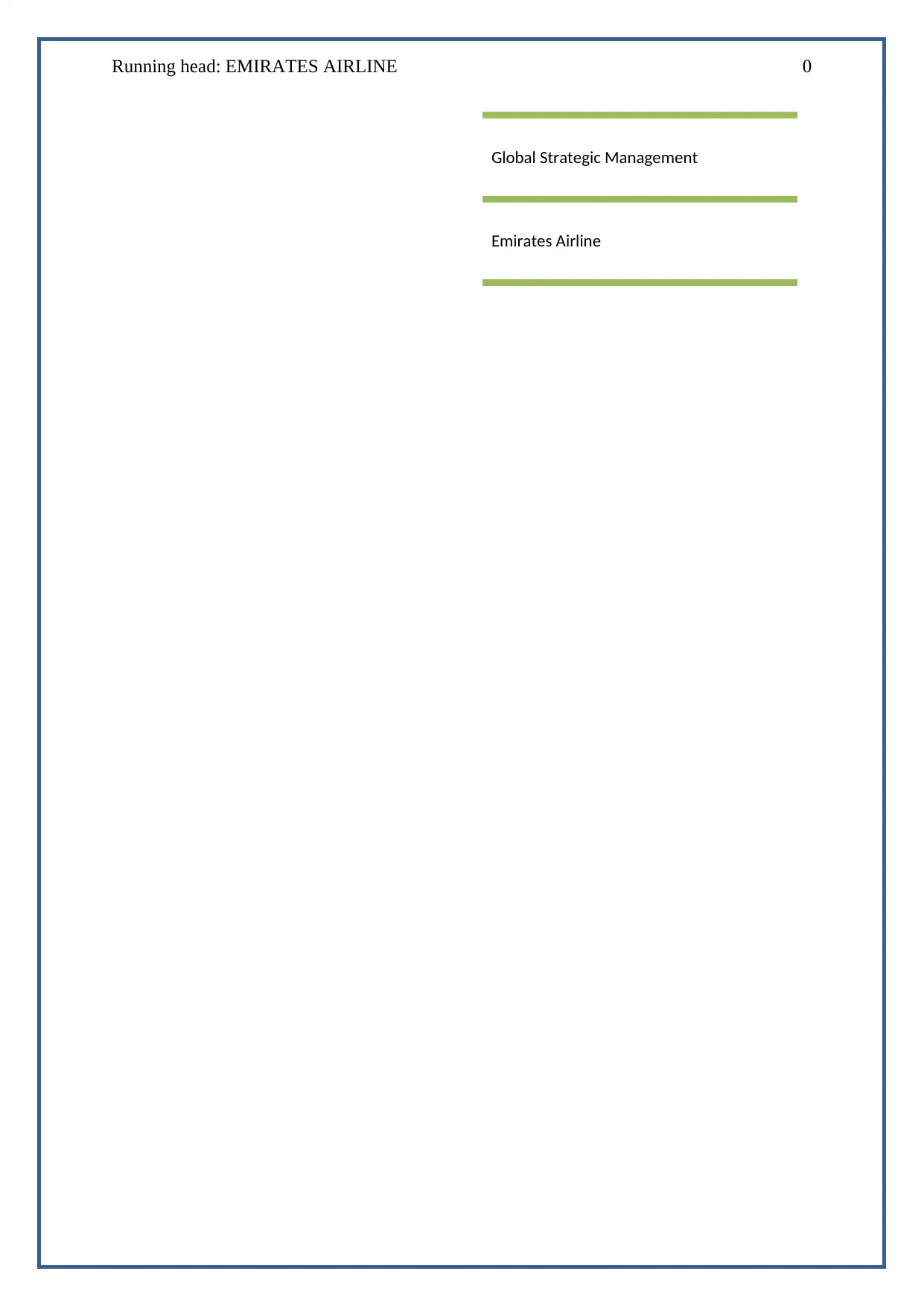
Running head: EMIRATES AIRLINE 0
Global Strategic Management
Emirates Airline
Global Strategic Management
Emirates Airline
Secure Best Marks with AI Grader
Need help grading? Try our AI Grader for instant feedback on your assignments.
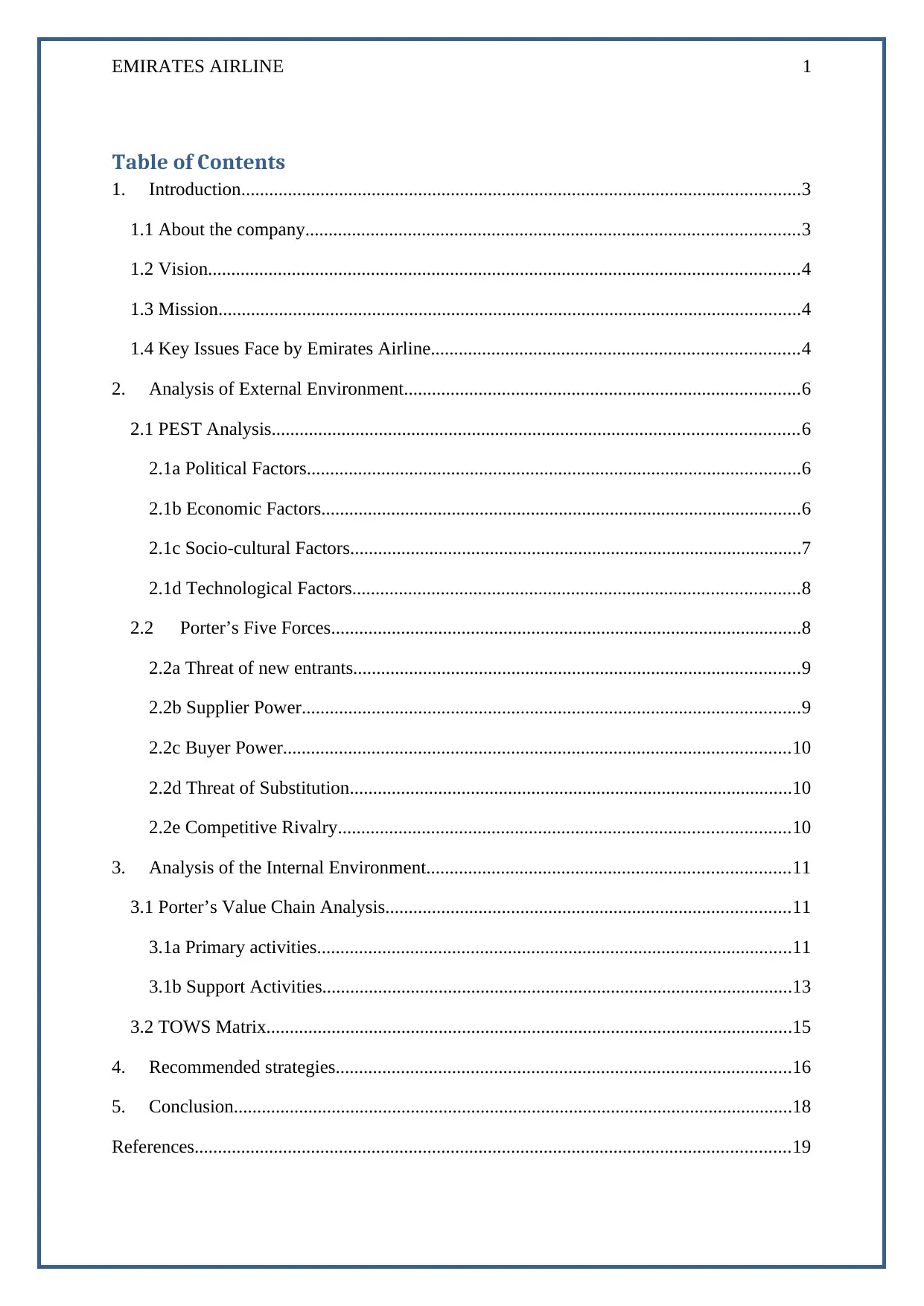
EMIRATES AIRLINE 1
Table of Contents
1. Introduction........................................................................................................................3
1.1 About the company..........................................................................................................3
1.2 Vision...............................................................................................................................4
1.3 Mission.............................................................................................................................4
1.4 Key Issues Face by Emirates Airline...............................................................................4
2. Analysis of External Environment.....................................................................................6
2.1 PEST Analysis.................................................................................................................6
2.1a Political Factors..........................................................................................................6
2.1b Economic Factors.......................................................................................................6
2.1c Socio-cultural Factors.................................................................................................7
2.1d Technological Factors................................................................................................8
2.2 Porter’s Five Forces.....................................................................................................8
2.2a Threat of new entrants................................................................................................9
2.2b Supplier Power...........................................................................................................9
2.2c Buyer Power.............................................................................................................10
2.2d Threat of Substitution...............................................................................................10
2.2e Competitive Rivalry.................................................................................................10
3. Analysis of the Internal Environment..............................................................................11
3.1 Porter’s Value Chain Analysis.......................................................................................11
3.1a Primary activities......................................................................................................11
3.1b Support Activities.....................................................................................................13
3.2 TOWS Matrix.................................................................................................................15
4. Recommended strategies..................................................................................................16
5. Conclusion........................................................................................................................18
References................................................................................................................................19
Table of Contents
1. Introduction........................................................................................................................3
1.1 About the company..........................................................................................................3
1.2 Vision...............................................................................................................................4
1.3 Mission.............................................................................................................................4
1.4 Key Issues Face by Emirates Airline...............................................................................4
2. Analysis of External Environment.....................................................................................6
2.1 PEST Analysis.................................................................................................................6
2.1a Political Factors..........................................................................................................6
2.1b Economic Factors.......................................................................................................6
2.1c Socio-cultural Factors.................................................................................................7
2.1d Technological Factors................................................................................................8
2.2 Porter’s Five Forces.....................................................................................................8
2.2a Threat of new entrants................................................................................................9
2.2b Supplier Power...........................................................................................................9
2.2c Buyer Power.............................................................................................................10
2.2d Threat of Substitution...............................................................................................10
2.2e Competitive Rivalry.................................................................................................10
3. Analysis of the Internal Environment..............................................................................11
3.1 Porter’s Value Chain Analysis.......................................................................................11
3.1a Primary activities......................................................................................................11
3.1b Support Activities.....................................................................................................13
3.2 TOWS Matrix.................................................................................................................15
4. Recommended strategies..................................................................................................16
5. Conclusion........................................................................................................................18
References................................................................................................................................19
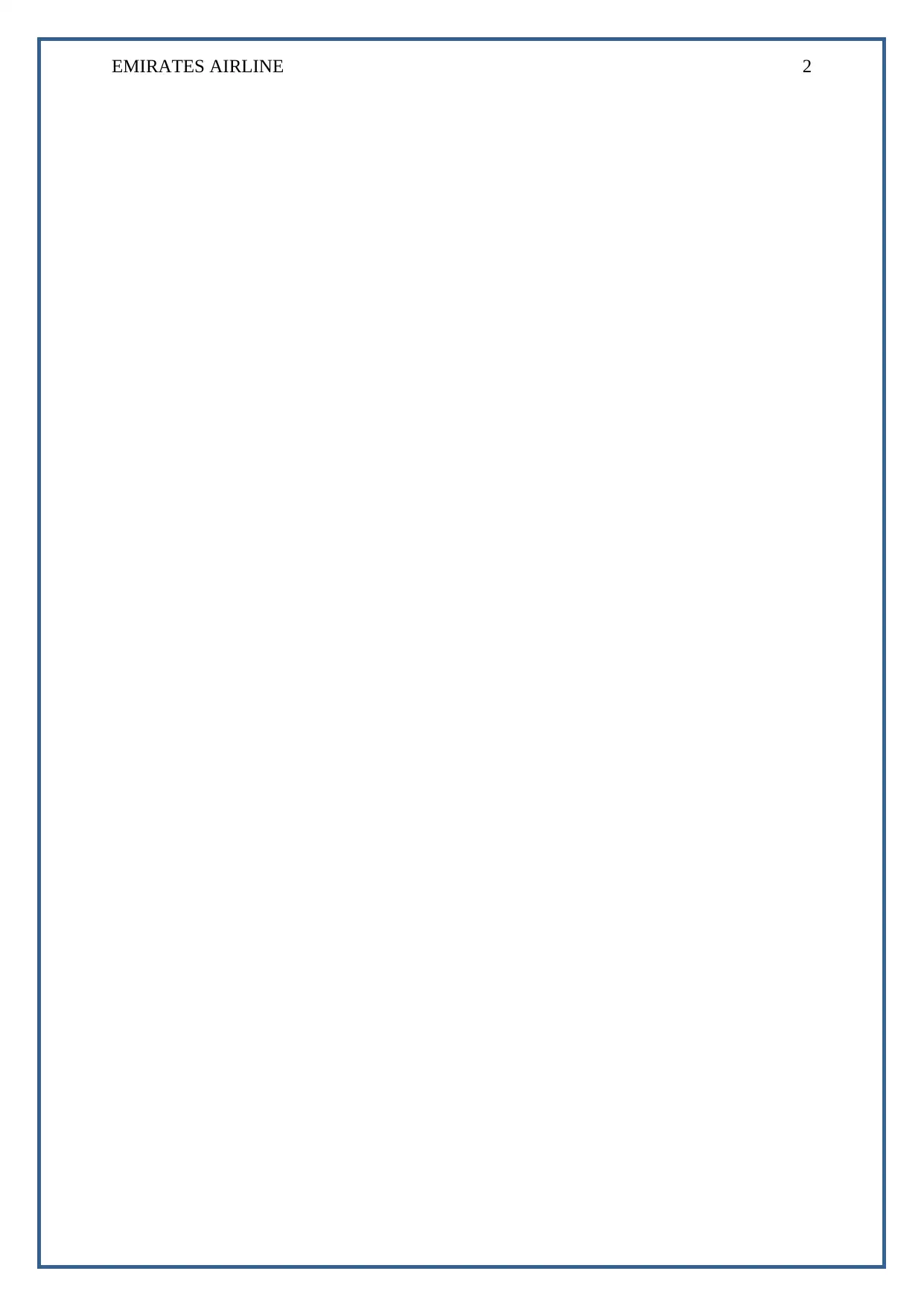
EMIRATES AIRLINE 2
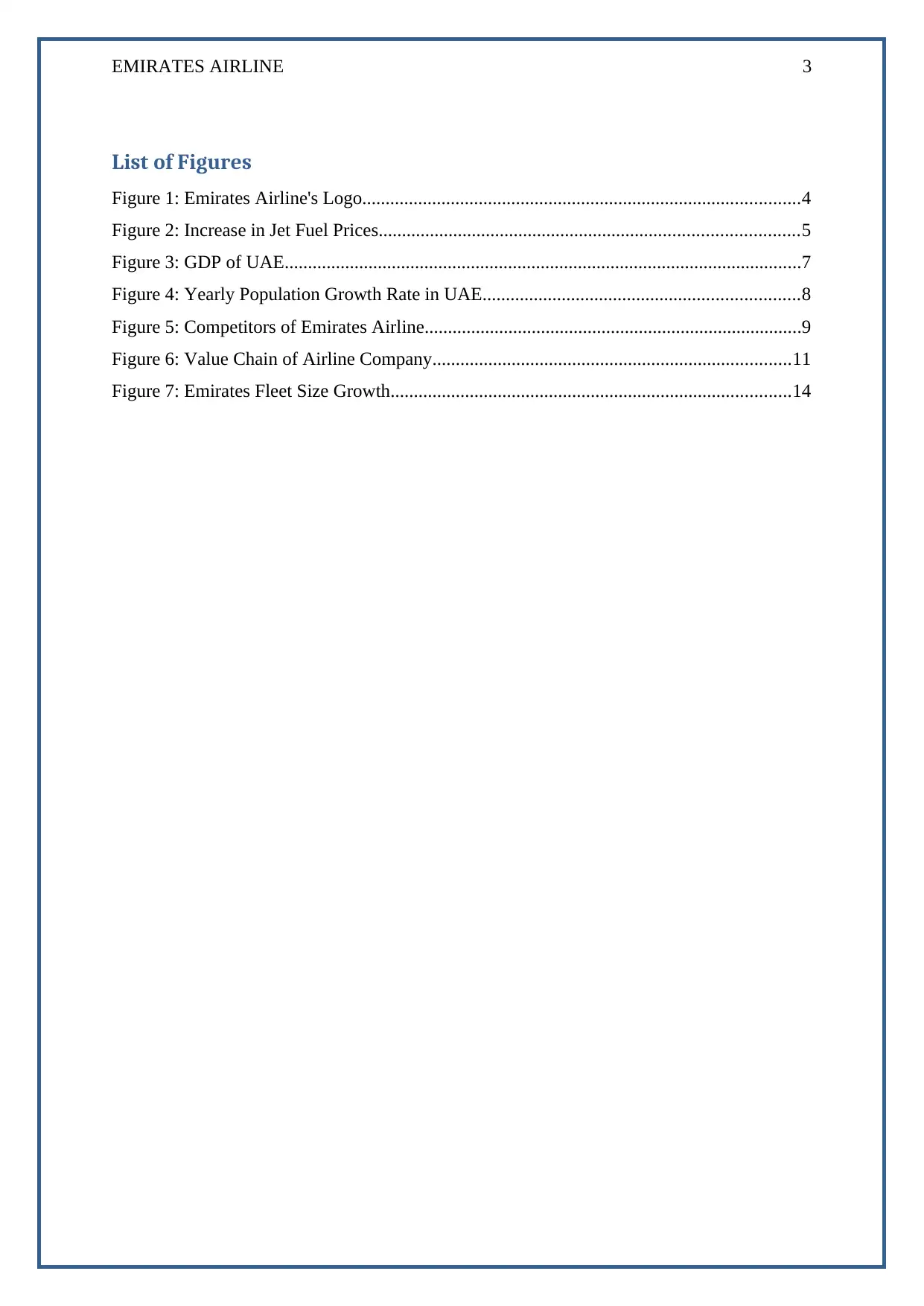
EMIRATES AIRLINE 3
List of Figures
Figure 1: Emirates Airline's Logo..............................................................................................4
Figure 2: Increase in Jet Fuel Prices..........................................................................................5
Figure 3: GDP of UAE...............................................................................................................7
Figure 4: Yearly Population Growth Rate in UAE....................................................................8
Figure 5: Competitors of Emirates Airline.................................................................................9
Figure 6: Value Chain of Airline Company.............................................................................11
Figure 7: Emirates Fleet Size Growth......................................................................................14
List of Figures
Figure 1: Emirates Airline's Logo..............................................................................................4
Figure 2: Increase in Jet Fuel Prices..........................................................................................5
Figure 3: GDP of UAE...............................................................................................................7
Figure 4: Yearly Population Growth Rate in UAE....................................................................8
Figure 5: Competitors of Emirates Airline.................................................................................9
Figure 6: Value Chain of Airline Company.............................................................................11
Figure 7: Emirates Fleet Size Growth......................................................................................14
Secure Best Marks with AI Grader
Need help grading? Try our AI Grader for instant feedback on your assignments.

EMIRATES AIRLINE 4
1. Introduction
The aim of this report is to introduce Emirates Airline, its vision, mission, products, and key
issues. Further, this report will analyse the external and internal environment and provide
strategy alternative and recommendations for sustaining the company’s future growth.
1.1 About the company
The Garhoud, Dubai, UAE headquarters based airline, Emirates, was founded in 25th March
1985 and it started its business of providing commercial air transportation services on 25th
October 1985 worldwide (Emirates, 2018a). The company is a subsidiary of ‘The Emirates
Group’, and it is wholly owned by the Investment Corporation of Dubai’s government. In the
aviation industry, the corporation has gained a prestigious rank due to its effective business
strategies that focus on encouraging fair competition, open skies policies, and transparency.
The fleet size of the firm includes 270 aircraft, and it has planned to add more than 20 aircraft
in the future (Planes Potters, 2018).
Currently, the company fly its passengers to more than 155 destinations in over 80 countries
around the world. Each week, more than 1,500 Emirates flights departed from Dubai airport,
and they fly its passengers on six continents (Altaf, 2017). The corporation has employed
more than 64,768 employees around the world (Emirates, 2017a). The services of the
company include worldwide destinations, regionally inspired cuisine, world-class facilities,
industry-leading in-flight entertainment and others. The seating options offered by the firm
include a full suite with doors, horizontal bed (without doors) and sleeper seats.
In 2017, Emirates Airline generated a profit of US$340 million, and the Emirates Group
reported a profit of US$670 million. The company reported a drop of 82.5 percent in its
profits as compared to 2016 profits. It is the first drop in the firm’s annual profit in previous
five years which caused due to competition, US dollar’s rise and travel restrictions (Al
Jazeera, 2017). As per Latest Oxford Economic Report, the aviation industry will contribute
US$53.1 billion in the economy or 37.5 percent of the GDP of Dubai by 2020. It is also
predicted that in the report that more than 754,500 jobs will be supported by the aviation
industry (Gulf News, 2014). Emirates Airline plays a crucial role in contributing to the
country’s economy as it is the largest airline in the Middle East.
1. Introduction
The aim of this report is to introduce Emirates Airline, its vision, mission, products, and key
issues. Further, this report will analyse the external and internal environment and provide
strategy alternative and recommendations for sustaining the company’s future growth.
1.1 About the company
The Garhoud, Dubai, UAE headquarters based airline, Emirates, was founded in 25th March
1985 and it started its business of providing commercial air transportation services on 25th
October 1985 worldwide (Emirates, 2018a). The company is a subsidiary of ‘The Emirates
Group’, and it is wholly owned by the Investment Corporation of Dubai’s government. In the
aviation industry, the corporation has gained a prestigious rank due to its effective business
strategies that focus on encouraging fair competition, open skies policies, and transparency.
The fleet size of the firm includes 270 aircraft, and it has planned to add more than 20 aircraft
in the future (Planes Potters, 2018).
Currently, the company fly its passengers to more than 155 destinations in over 80 countries
around the world. Each week, more than 1,500 Emirates flights departed from Dubai airport,
and they fly its passengers on six continents (Altaf, 2017). The corporation has employed
more than 64,768 employees around the world (Emirates, 2017a). The services of the
company include worldwide destinations, regionally inspired cuisine, world-class facilities,
industry-leading in-flight entertainment and others. The seating options offered by the firm
include a full suite with doors, horizontal bed (without doors) and sleeper seats.
In 2017, Emirates Airline generated a profit of US$340 million, and the Emirates Group
reported a profit of US$670 million. The company reported a drop of 82.5 percent in its
profits as compared to 2016 profits. It is the first drop in the firm’s annual profit in previous
five years which caused due to competition, US dollar’s rise and travel restrictions (Al
Jazeera, 2017). As per Latest Oxford Economic Report, the aviation industry will contribute
US$53.1 billion in the economy or 37.5 percent of the GDP of Dubai by 2020. It is also
predicted that in the report that more than 754,500 jobs will be supported by the aviation
industry (Gulf News, 2014). Emirates Airline plays a crucial role in contributing to the
country’s economy as it is the largest airline in the Middle East.
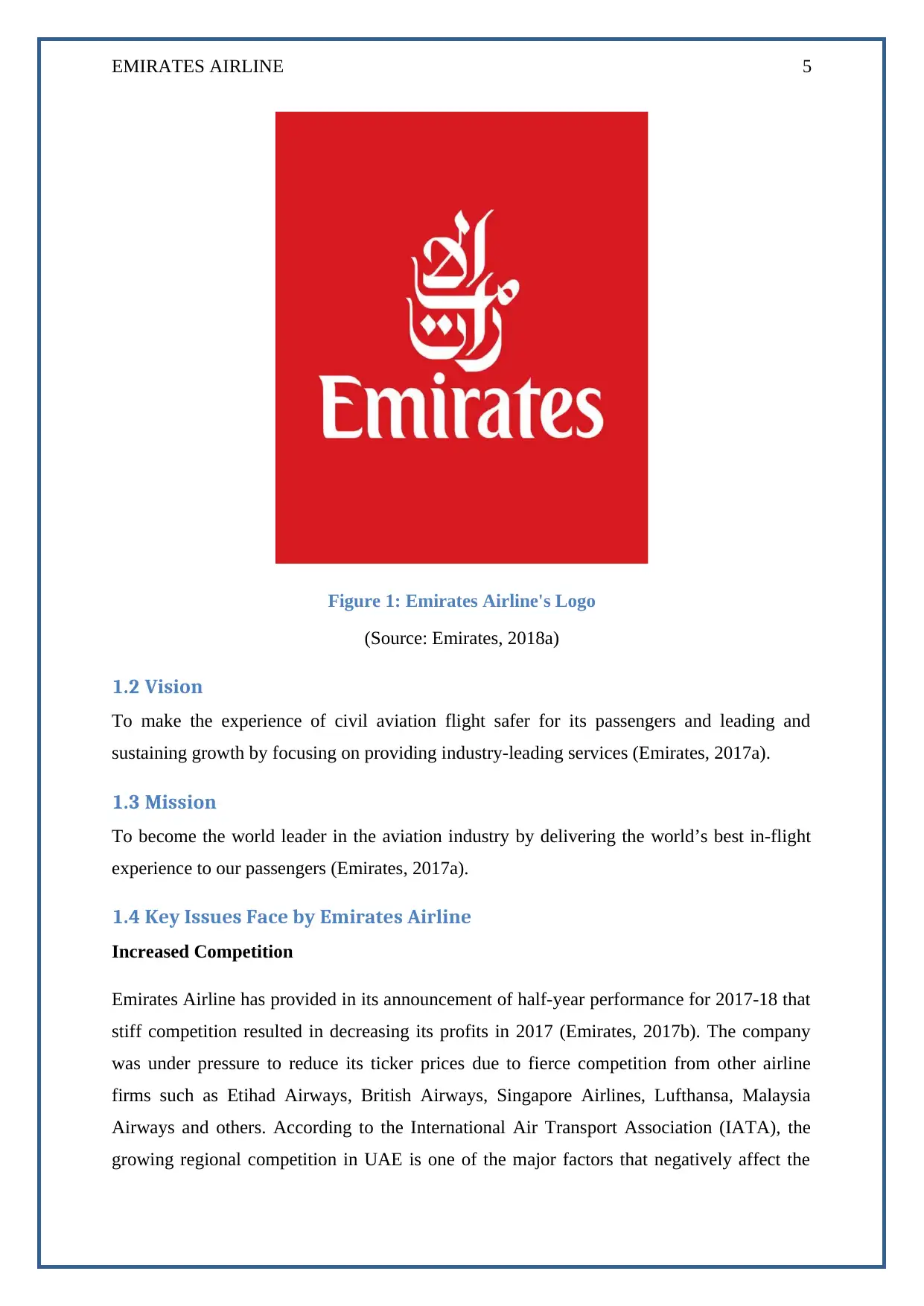
EMIRATES AIRLINE 5
Figure 1: Emirates Airline's Logo
(Source: Emirates, 2018a)
1.2 Vision
To make the experience of civil aviation flight safer for its passengers and leading and
sustaining growth by focusing on providing industry-leading services (Emirates, 2017a).
1.3 Mission
To become the world leader in the aviation industry by delivering the world’s best in-flight
experience to our passengers (Emirates, 2017a).
1.4 Key Issues Face by Emirates Airline
Increased Competition
Emirates Airline has provided in its announcement of half-year performance for 2017-18 that
stiff competition resulted in decreasing its profits in 2017 (Emirates, 2017b). The company
was under pressure to reduce its ticker prices due to fierce competition from other airline
firms such as Etihad Airways, British Airways, Singapore Airlines, Lufthansa, Malaysia
Airways and others. According to the International Air Transport Association (IATA), the
growing regional competition in UAE is one of the major factors that negatively affect the
Figure 1: Emirates Airline's Logo
(Source: Emirates, 2018a)
1.2 Vision
To make the experience of civil aviation flight safer for its passengers and leading and
sustaining growth by focusing on providing industry-leading services (Emirates, 2017a).
1.3 Mission
To become the world leader in the aviation industry by delivering the world’s best in-flight
experience to our passengers (Emirates, 2017a).
1.4 Key Issues Face by Emirates Airline
Increased Competition
Emirates Airline has provided in its announcement of half-year performance for 2017-18 that
stiff competition resulted in decreasing its profits in 2017 (Emirates, 2017b). The company
was under pressure to reduce its ticker prices due to fierce competition from other airline
firms such as Etihad Airways, British Airways, Singapore Airlines, Lufthansa, Malaysia
Airways and others. According to the International Air Transport Association (IATA), the
growing regional competition in UAE is one of the major factors that negatively affect the
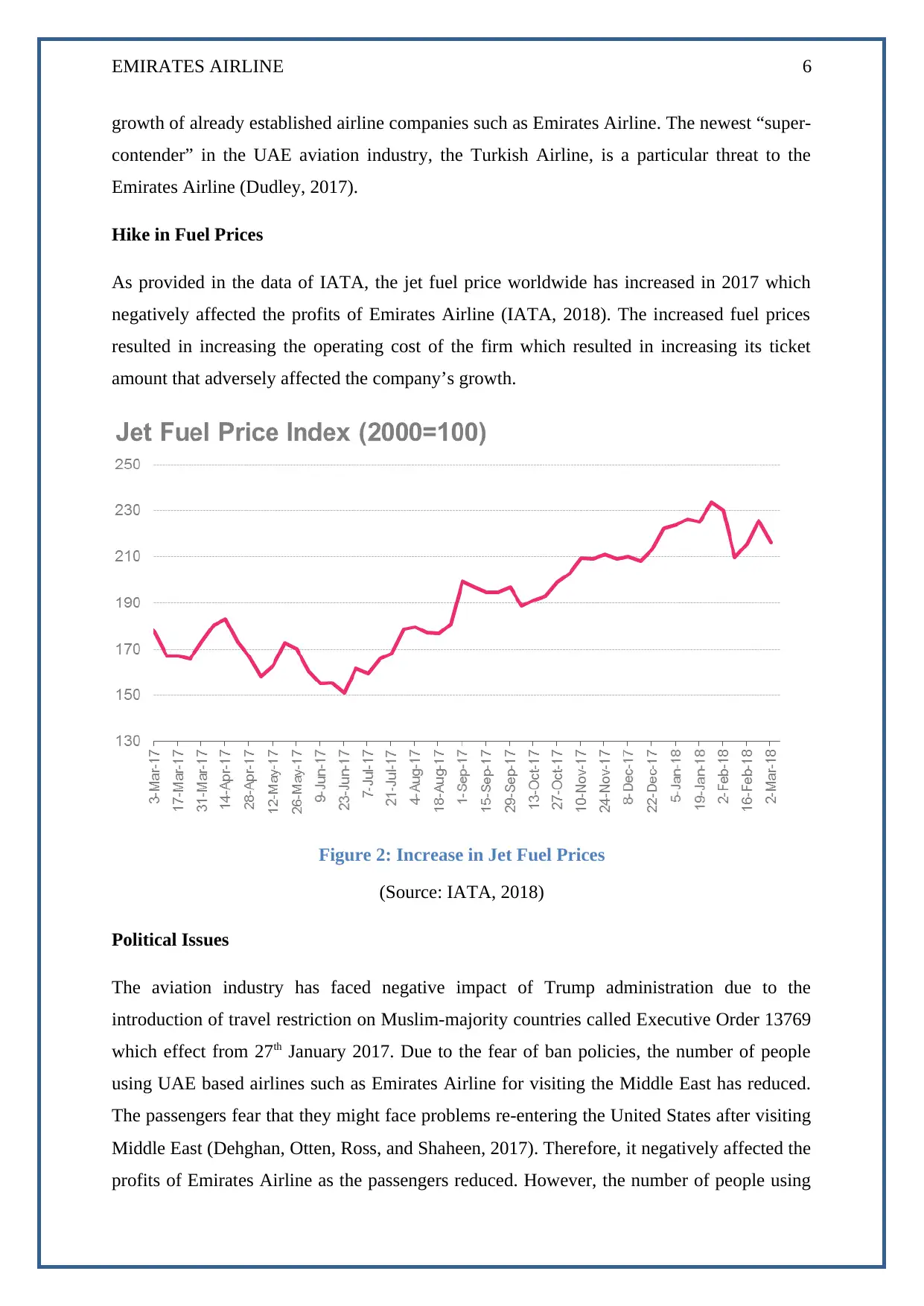
EMIRATES AIRLINE 6
growth of already established airline companies such as Emirates Airline. The newest “super-
contender” in the UAE aviation industry, the Turkish Airline, is a particular threat to the
Emirates Airline (Dudley, 2017).
Hike in Fuel Prices
As provided in the data of IATA, the jet fuel price worldwide has increased in 2017 which
negatively affected the profits of Emirates Airline (IATA, 2018). The increased fuel prices
resulted in increasing the operating cost of the firm which resulted in increasing its ticket
amount that adversely affected the company’s growth.
Figure 2: Increase in Jet Fuel Prices
(Source: IATA, 2018)
Political Issues
The aviation industry has faced negative impact of Trump administration due to the
introduction of travel restriction on Muslim-majority countries called Executive Order 13769
which effect from 27th January 2017. Due to the fear of ban policies, the number of people
using UAE based airlines such as Emirates Airline for visiting the Middle East has reduced.
The passengers fear that they might face problems re-entering the United States after visiting
Middle East (Dehghan, Otten, Ross, and Shaheen, 2017). Therefore, it negatively affected the
profits of Emirates Airline as the passengers reduced. However, the number of people using
growth of already established airline companies such as Emirates Airline. The newest “super-
contender” in the UAE aviation industry, the Turkish Airline, is a particular threat to the
Emirates Airline (Dudley, 2017).
Hike in Fuel Prices
As provided in the data of IATA, the jet fuel price worldwide has increased in 2017 which
negatively affected the profits of Emirates Airline (IATA, 2018). The increased fuel prices
resulted in increasing the operating cost of the firm which resulted in increasing its ticket
amount that adversely affected the company’s growth.
Figure 2: Increase in Jet Fuel Prices
(Source: IATA, 2018)
Political Issues
The aviation industry has faced negative impact of Trump administration due to the
introduction of travel restriction on Muslim-majority countries called Executive Order 13769
which effect from 27th January 2017. Due to the fear of ban policies, the number of people
using UAE based airlines such as Emirates Airline for visiting the Middle East has reduced.
The passengers fear that they might face problems re-entering the United States after visiting
Middle East (Dehghan, Otten, Ross, and Shaheen, 2017). Therefore, it negatively affected the
profits of Emirates Airline as the passengers reduced. However, the number of people using
Paraphrase This Document
Need a fresh take? Get an instant paraphrase of this document with our AI Paraphraser
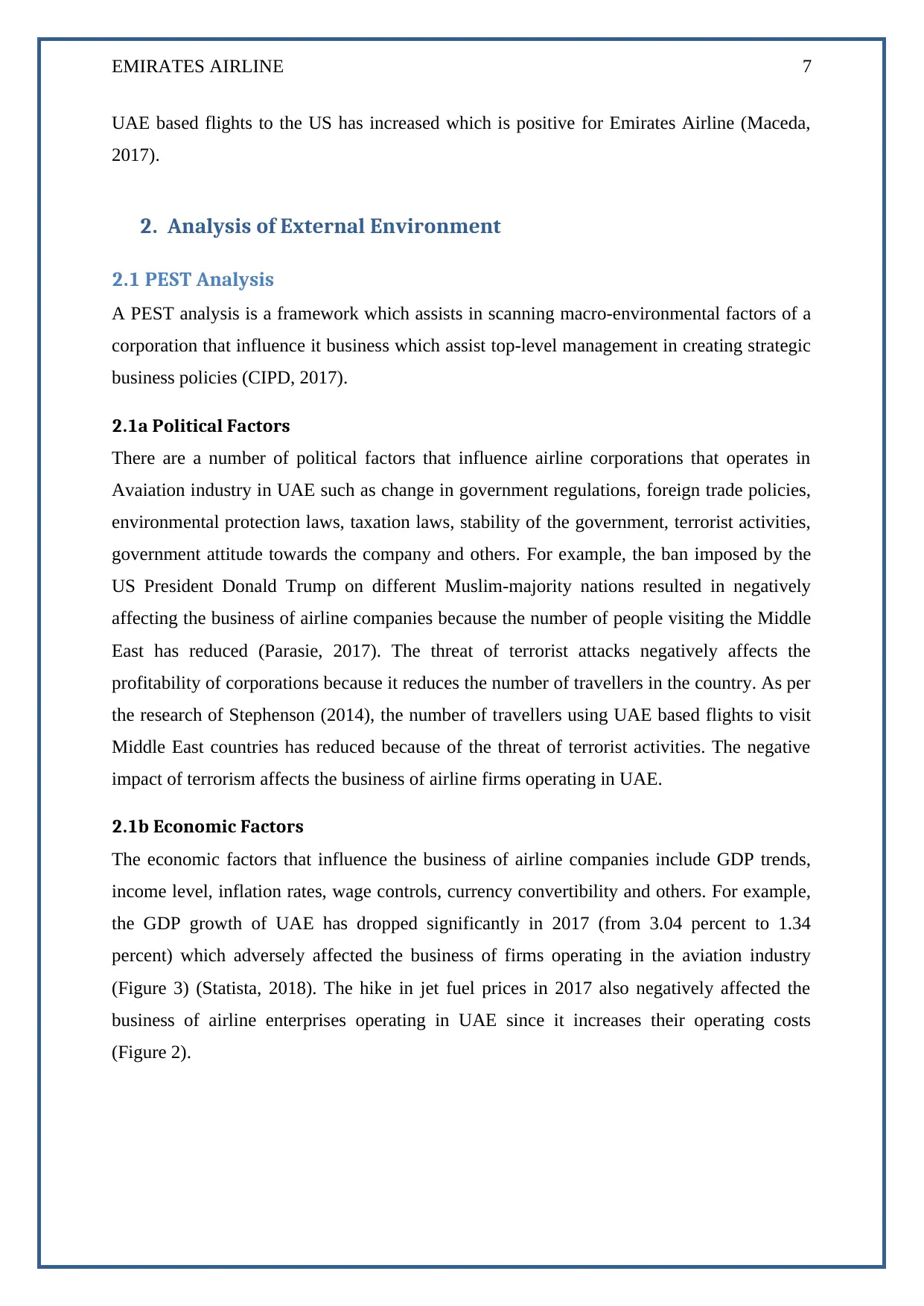
EMIRATES AIRLINE 7
UAE based flights to the US has increased which is positive for Emirates Airline (Maceda,
2017).
2. Analysis of External Environment
2.1 PEST Analysis
A PEST analysis is a framework which assists in scanning macro-environmental factors of a
corporation that influence it business which assist top-level management in creating strategic
business policies (CIPD, 2017).
2.1a Political Factors
There are a number of political factors that influence airline corporations that operates in
Avaiation industry in UAE such as change in government regulations, foreign trade policies,
environmental protection laws, taxation laws, stability of the government, terrorist activities,
government attitude towards the company and others. For example, the ban imposed by the
US President Donald Trump on different Muslim-majority nations resulted in negatively
affecting the business of airline companies because the number of people visiting the Middle
East has reduced (Parasie, 2017). The threat of terrorist attacks negatively affects the
profitability of corporations because it reduces the number of travellers in the country. As per
the research of Stephenson (2014), the number of travellers using UAE based flights to visit
Middle East countries has reduced because of the threat of terrorist activities. The negative
impact of terrorism affects the business of airline firms operating in UAE.
2.1b Economic Factors
The economic factors that influence the business of airline companies include GDP trends,
income level, inflation rates, wage controls, currency convertibility and others. For example,
the GDP growth of UAE has dropped significantly in 2017 (from 3.04 percent to 1.34
percent) which adversely affected the business of firms operating in the aviation industry
(Figure 3) (Statista, 2018). The hike in jet fuel prices in 2017 also negatively affected the
business of airline enterprises operating in UAE since it increases their operating costs
(Figure 2).
UAE based flights to the US has increased which is positive for Emirates Airline (Maceda,
2017).
2. Analysis of External Environment
2.1 PEST Analysis
A PEST analysis is a framework which assists in scanning macro-environmental factors of a
corporation that influence it business which assist top-level management in creating strategic
business policies (CIPD, 2017).
2.1a Political Factors
There are a number of political factors that influence airline corporations that operates in
Avaiation industry in UAE such as change in government regulations, foreign trade policies,
environmental protection laws, taxation laws, stability of the government, terrorist activities,
government attitude towards the company and others. For example, the ban imposed by the
US President Donald Trump on different Muslim-majority nations resulted in negatively
affecting the business of airline companies because the number of people visiting the Middle
East has reduced (Parasie, 2017). The threat of terrorist attacks negatively affects the
profitability of corporations because it reduces the number of travellers in the country. As per
the research of Stephenson (2014), the number of travellers using UAE based flights to visit
Middle East countries has reduced because of the threat of terrorist activities. The negative
impact of terrorism affects the business of airline firms operating in UAE.
2.1b Economic Factors
The economic factors that influence the business of airline companies include GDP trends,
income level, inflation rates, wage controls, currency convertibility and others. For example,
the GDP growth of UAE has dropped significantly in 2017 (from 3.04 percent to 1.34
percent) which adversely affected the business of firms operating in the aviation industry
(Figure 3) (Statista, 2018). The hike in jet fuel prices in 2017 also negatively affected the
business of airline enterprises operating in UAE since it increases their operating costs
(Figure 2).
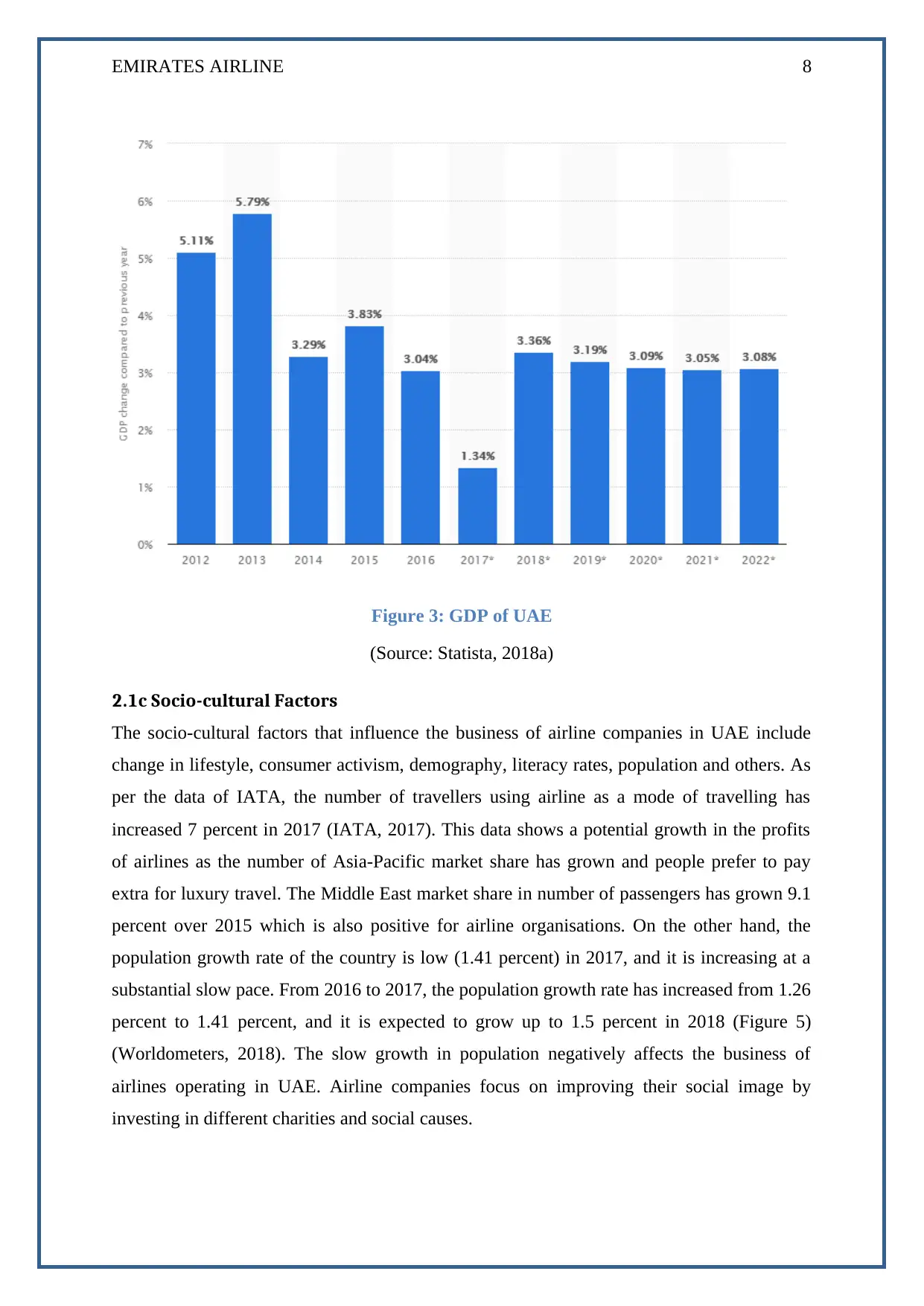
EMIRATES AIRLINE 8
Figure 3: GDP of UAE
(Source: Statista, 2018a)
2.1c Socio-cultural Factors
The socio-cultural factors that influence the business of airline companies in UAE include
change in lifestyle, consumer activism, demography, literacy rates, population and others. As
per the data of IATA, the number of travellers using airline as a mode of travelling has
increased 7 percent in 2017 (IATA, 2017). This data shows a potential growth in the profits
of airlines as the number of Asia-Pacific market share has grown and people prefer to pay
extra for luxury travel. The Middle East market share in number of passengers has grown 9.1
percent over 2015 which is also positive for airline organisations. On the other hand, the
population growth rate of the country is low (1.41 percent) in 2017, and it is increasing at a
substantial slow pace. From 2016 to 2017, the population growth rate has increased from 1.26
percent to 1.41 percent, and it is expected to grow up to 1.5 percent in 2018 (Figure 5)
(Worldometers, 2018). The slow growth in population negatively affects the business of
airlines operating in UAE. Airline companies focus on improving their social image by
investing in different charities and social causes.
Figure 3: GDP of UAE
(Source: Statista, 2018a)
2.1c Socio-cultural Factors
The socio-cultural factors that influence the business of airline companies in UAE include
change in lifestyle, consumer activism, demography, literacy rates, population and others. As
per the data of IATA, the number of travellers using airline as a mode of travelling has
increased 7 percent in 2017 (IATA, 2017). This data shows a potential growth in the profits
of airlines as the number of Asia-Pacific market share has grown and people prefer to pay
extra for luxury travel. The Middle East market share in number of passengers has grown 9.1
percent over 2015 which is also positive for airline organisations. On the other hand, the
population growth rate of the country is low (1.41 percent) in 2017, and it is increasing at a
substantial slow pace. From 2016 to 2017, the population growth rate has increased from 1.26
percent to 1.41 percent, and it is expected to grow up to 1.5 percent in 2018 (Figure 5)
(Worldometers, 2018). The slow growth in population negatively affects the business of
airlines operating in UAE. Airline companies focus on improving their social image by
investing in different charities and social causes.
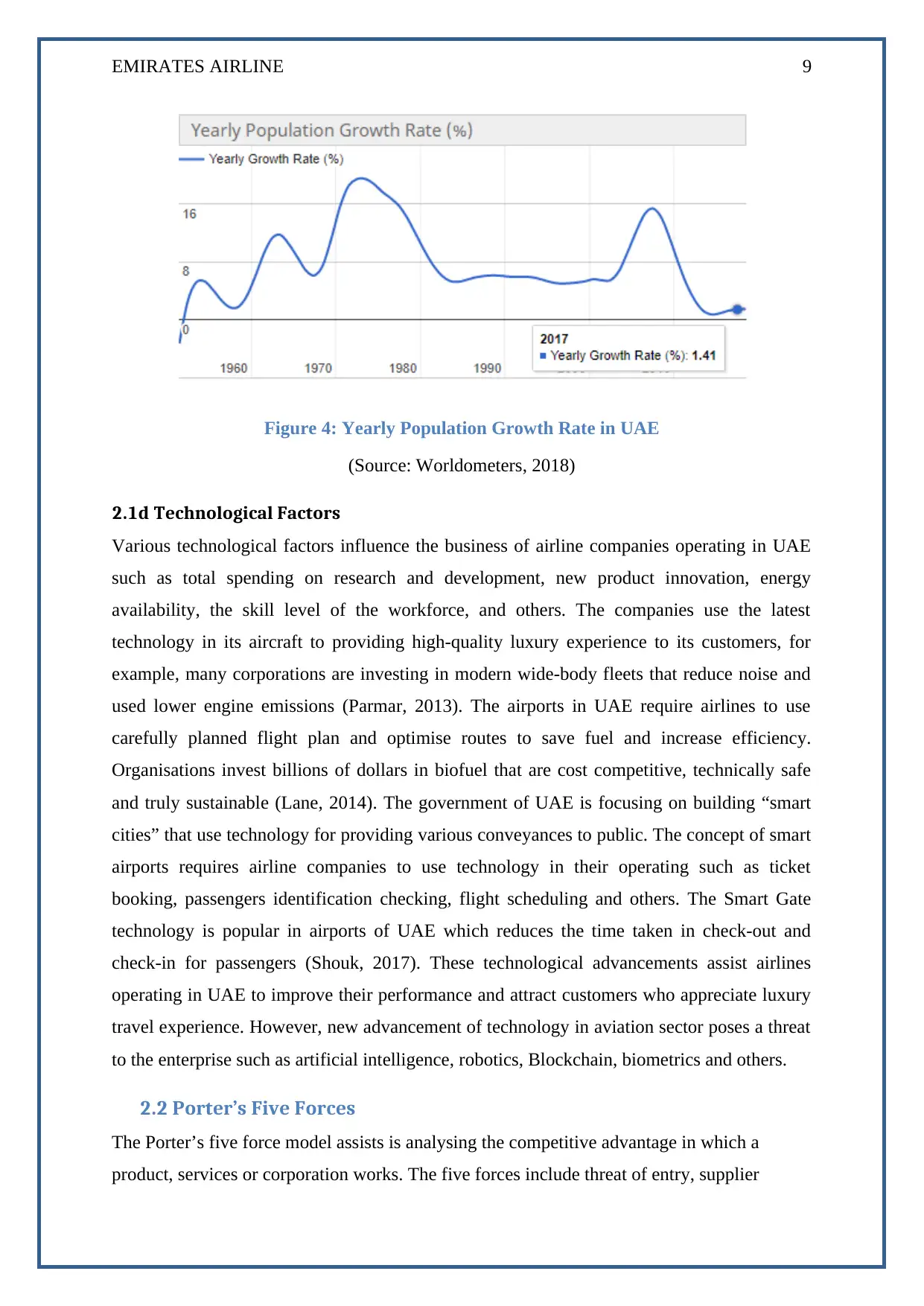
EMIRATES AIRLINE 9
Figure 4: Yearly Population Growth Rate in UAE
(Source: Worldometers, 2018)
2.1d Technological Factors
Various technological factors influence the business of airline companies operating in UAE
such as total spending on research and development, new product innovation, energy
availability, the skill level of the workforce, and others. The companies use the latest
technology in its aircraft to providing high-quality luxury experience to its customers, for
example, many corporations are investing in modern wide-body fleets that reduce noise and
used lower engine emissions (Parmar, 2013). The airports in UAE require airlines to use
carefully planned flight plan and optimise routes to save fuel and increase efficiency.
Organisations invest billions of dollars in biofuel that are cost competitive, technically safe
and truly sustainable (Lane, 2014). The government of UAE is focusing on building “smart
cities” that use technology for providing various conveyances to public. The concept of smart
airports requires airline companies to use technology in their operating such as ticket
booking, passengers identification checking, flight scheduling and others. The Smart Gate
technology is popular in airports of UAE which reduces the time taken in check-out and
check-in for passengers (Shouk, 2017). These technological advancements assist airlines
operating in UAE to improve their performance and attract customers who appreciate luxury
travel experience. However, new advancement of technology in aviation sector poses a threat
to the enterprise such as artificial intelligence, robotics, Blockchain, biometrics and others.
2.2 Porter’s Five Forces
The Porter’s five force model assists is analysing the competitive advantage in which a
product, services or corporation works. The five forces include threat of entry, supplier
Figure 4: Yearly Population Growth Rate in UAE
(Source: Worldometers, 2018)
2.1d Technological Factors
Various technological factors influence the business of airline companies operating in UAE
such as total spending on research and development, new product innovation, energy
availability, the skill level of the workforce, and others. The companies use the latest
technology in its aircraft to providing high-quality luxury experience to its customers, for
example, many corporations are investing in modern wide-body fleets that reduce noise and
used lower engine emissions (Parmar, 2013). The airports in UAE require airlines to use
carefully planned flight plan and optimise routes to save fuel and increase efficiency.
Organisations invest billions of dollars in biofuel that are cost competitive, technically safe
and truly sustainable (Lane, 2014). The government of UAE is focusing on building “smart
cities” that use technology for providing various conveyances to public. The concept of smart
airports requires airline companies to use technology in their operating such as ticket
booking, passengers identification checking, flight scheduling and others. The Smart Gate
technology is popular in airports of UAE which reduces the time taken in check-out and
check-in for passengers (Shouk, 2017). These technological advancements assist airlines
operating in UAE to improve their performance and attract customers who appreciate luxury
travel experience. However, new advancement of technology in aviation sector poses a threat
to the enterprise such as artificial intelligence, robotics, Blockchain, biometrics and others.
2.2 Porter’s Five Forces
The Porter’s five force model assists is analysing the competitive advantage in which a
product, services or corporation works. The five forces include threat of entry, supplier
Secure Best Marks with AI Grader
Need help grading? Try our AI Grader for instant feedback on your assignments.
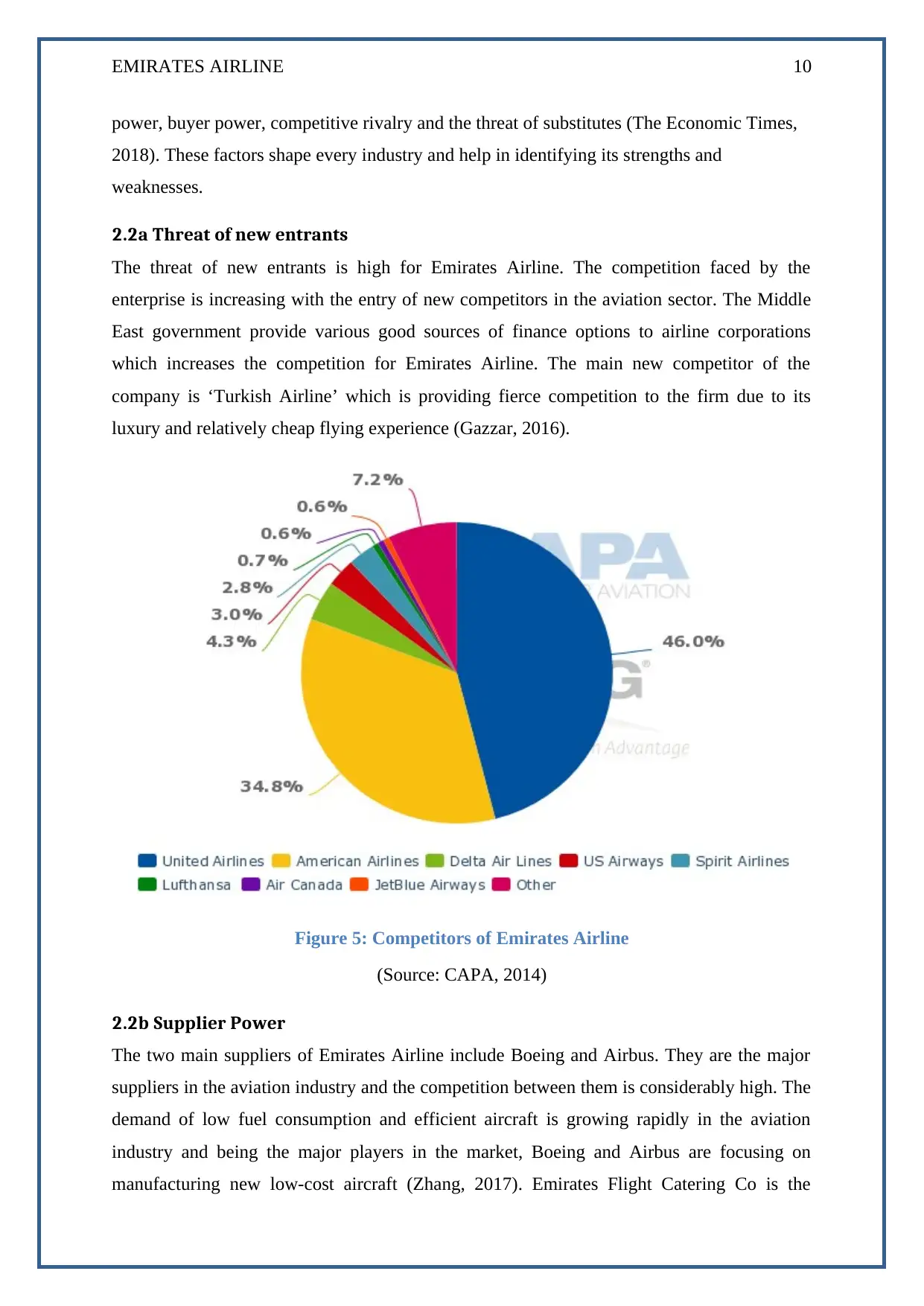
EMIRATES AIRLINE 10
power, buyer power, competitive rivalry and the threat of substitutes (The Economic Times,
2018). These factors shape every industry and help in identifying its strengths and
weaknesses.
2.2a Threat of new entrants
The threat of new entrants is high for Emirates Airline. The competition faced by the
enterprise is increasing with the entry of new competitors in the aviation sector. The Middle
East government provide various good sources of finance options to airline corporations
which increases the competition for Emirates Airline. The main new competitor of the
company is ‘Turkish Airline’ which is providing fierce competition to the firm due to its
luxury and relatively cheap flying experience (Gazzar, 2016).
Figure 5: Competitors of Emirates Airline
(Source: CAPA, 2014)
2.2b Supplier Power
The two main suppliers of Emirates Airline include Boeing and Airbus. They are the major
suppliers in the aviation industry and the competition between them is considerably high. The
demand of low fuel consumption and efficient aircraft is growing rapidly in the aviation
industry and being the major players in the market, Boeing and Airbus are focusing on
manufacturing new low-cost aircraft (Zhang, 2017). Emirates Flight Catering Co is the
power, buyer power, competitive rivalry and the threat of substitutes (The Economic Times,
2018). These factors shape every industry and help in identifying its strengths and
weaknesses.
2.2a Threat of new entrants
The threat of new entrants is high for Emirates Airline. The competition faced by the
enterprise is increasing with the entry of new competitors in the aviation sector. The Middle
East government provide various good sources of finance options to airline corporations
which increases the competition for Emirates Airline. The main new competitor of the
company is ‘Turkish Airline’ which is providing fierce competition to the firm due to its
luxury and relatively cheap flying experience (Gazzar, 2016).
Figure 5: Competitors of Emirates Airline
(Source: CAPA, 2014)
2.2b Supplier Power
The two main suppliers of Emirates Airline include Boeing and Airbus. They are the major
suppliers in the aviation industry and the competition between them is considerably high. The
demand of low fuel consumption and efficient aircraft is growing rapidly in the aviation
industry and being the major players in the market, Boeing and Airbus are focusing on
manufacturing new low-cost aircraft (Zhang, 2017). Emirates Flight Catering Co is the
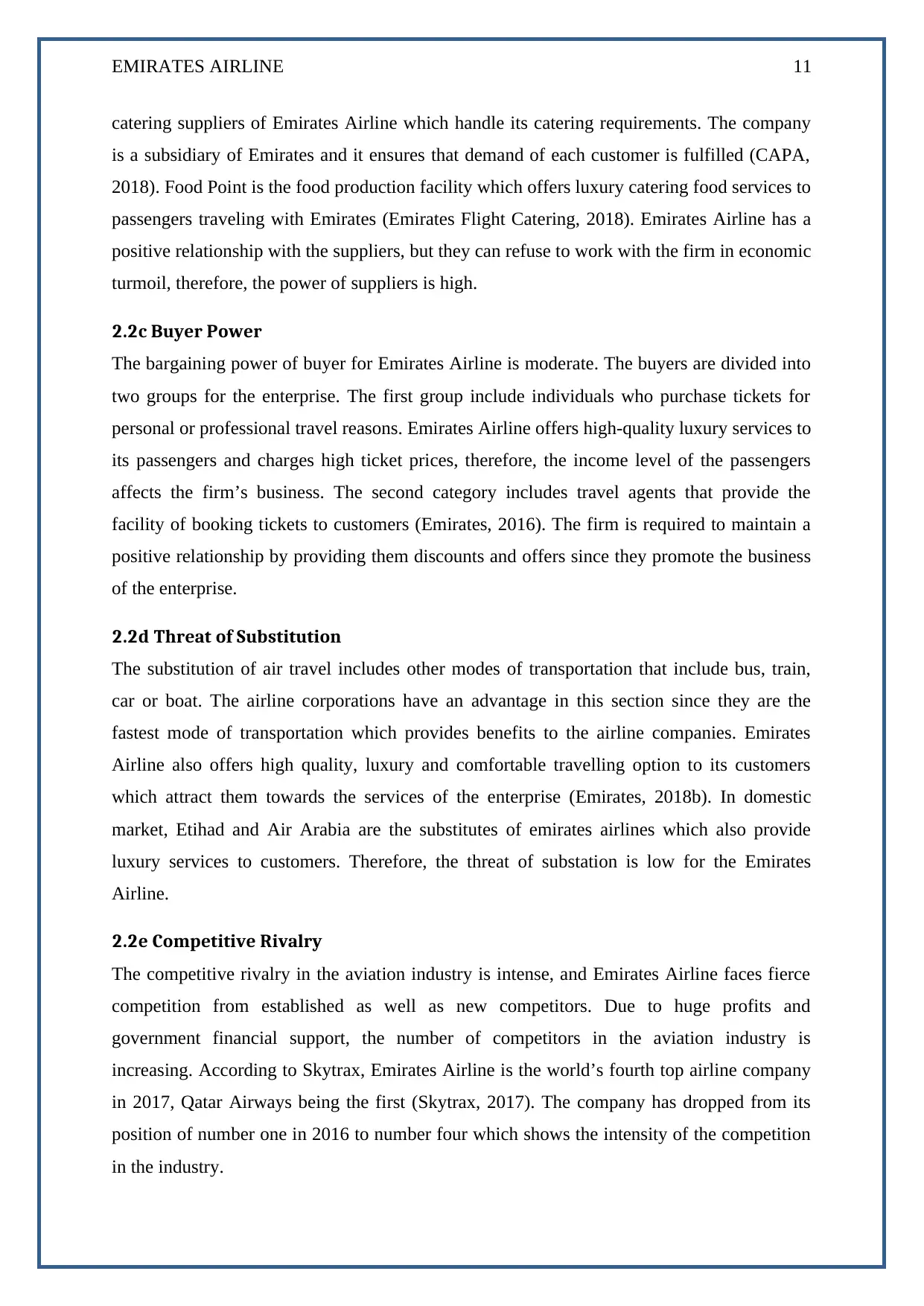
EMIRATES AIRLINE 11
catering suppliers of Emirates Airline which handle its catering requirements. The company
is a subsidiary of Emirates and it ensures that demand of each customer is fulfilled (CAPA,
2018). Food Point is the food production facility which offers luxury catering food services to
passengers traveling with Emirates (Emirates Flight Catering, 2018). Emirates Airline has a
positive relationship with the suppliers, but they can refuse to work with the firm in economic
turmoil, therefore, the power of suppliers is high.
2.2c Buyer Power
The bargaining power of buyer for Emirates Airline is moderate. The buyers are divided into
two groups for the enterprise. The first group include individuals who purchase tickets for
personal or professional travel reasons. Emirates Airline offers high-quality luxury services to
its passengers and charges high ticket prices, therefore, the income level of the passengers
affects the firm’s business. The second category includes travel agents that provide the
facility of booking tickets to customers (Emirates, 2016). The firm is required to maintain a
positive relationship by providing them discounts and offers since they promote the business
of the enterprise.
2.2d Threat of Substitution
The substitution of air travel includes other modes of transportation that include bus, train,
car or boat. The airline corporations have an advantage in this section since they are the
fastest mode of transportation which provides benefits to the airline companies. Emirates
Airline also offers high quality, luxury and comfortable travelling option to its customers
which attract them towards the services of the enterprise (Emirates, 2018b). In domestic
market, Etihad and Air Arabia are the substitutes of emirates airlines which also provide
luxury services to customers. Therefore, the threat of substation is low for the Emirates
Airline.
2.2e Competitive Rivalry
The competitive rivalry in the aviation industry is intense, and Emirates Airline faces fierce
competition from established as well as new competitors. Due to huge profits and
government financial support, the number of competitors in the aviation industry is
increasing. According to Skytrax, Emirates Airline is the world’s fourth top airline company
in 2017, Qatar Airways being the first (Skytrax, 2017). The company has dropped from its
position of number one in 2016 to number four which shows the intensity of the competition
in the industry.
catering suppliers of Emirates Airline which handle its catering requirements. The company
is a subsidiary of Emirates and it ensures that demand of each customer is fulfilled (CAPA,
2018). Food Point is the food production facility which offers luxury catering food services to
passengers traveling with Emirates (Emirates Flight Catering, 2018). Emirates Airline has a
positive relationship with the suppliers, but they can refuse to work with the firm in economic
turmoil, therefore, the power of suppliers is high.
2.2c Buyer Power
The bargaining power of buyer for Emirates Airline is moderate. The buyers are divided into
two groups for the enterprise. The first group include individuals who purchase tickets for
personal or professional travel reasons. Emirates Airline offers high-quality luxury services to
its passengers and charges high ticket prices, therefore, the income level of the passengers
affects the firm’s business. The second category includes travel agents that provide the
facility of booking tickets to customers (Emirates, 2016). The firm is required to maintain a
positive relationship by providing them discounts and offers since they promote the business
of the enterprise.
2.2d Threat of Substitution
The substitution of air travel includes other modes of transportation that include bus, train,
car or boat. The airline corporations have an advantage in this section since they are the
fastest mode of transportation which provides benefits to the airline companies. Emirates
Airline also offers high quality, luxury and comfortable travelling option to its customers
which attract them towards the services of the enterprise (Emirates, 2018b). In domestic
market, Etihad and Air Arabia are the substitutes of emirates airlines which also provide
luxury services to customers. Therefore, the threat of substation is low for the Emirates
Airline.
2.2e Competitive Rivalry
The competitive rivalry in the aviation industry is intense, and Emirates Airline faces fierce
competition from established as well as new competitors. Due to huge profits and
government financial support, the number of competitors in the aviation industry is
increasing. According to Skytrax, Emirates Airline is the world’s fourth top airline company
in 2017, Qatar Airways being the first (Skytrax, 2017). The company has dropped from its
position of number one in 2016 to number four which shows the intensity of the competition
in the industry.
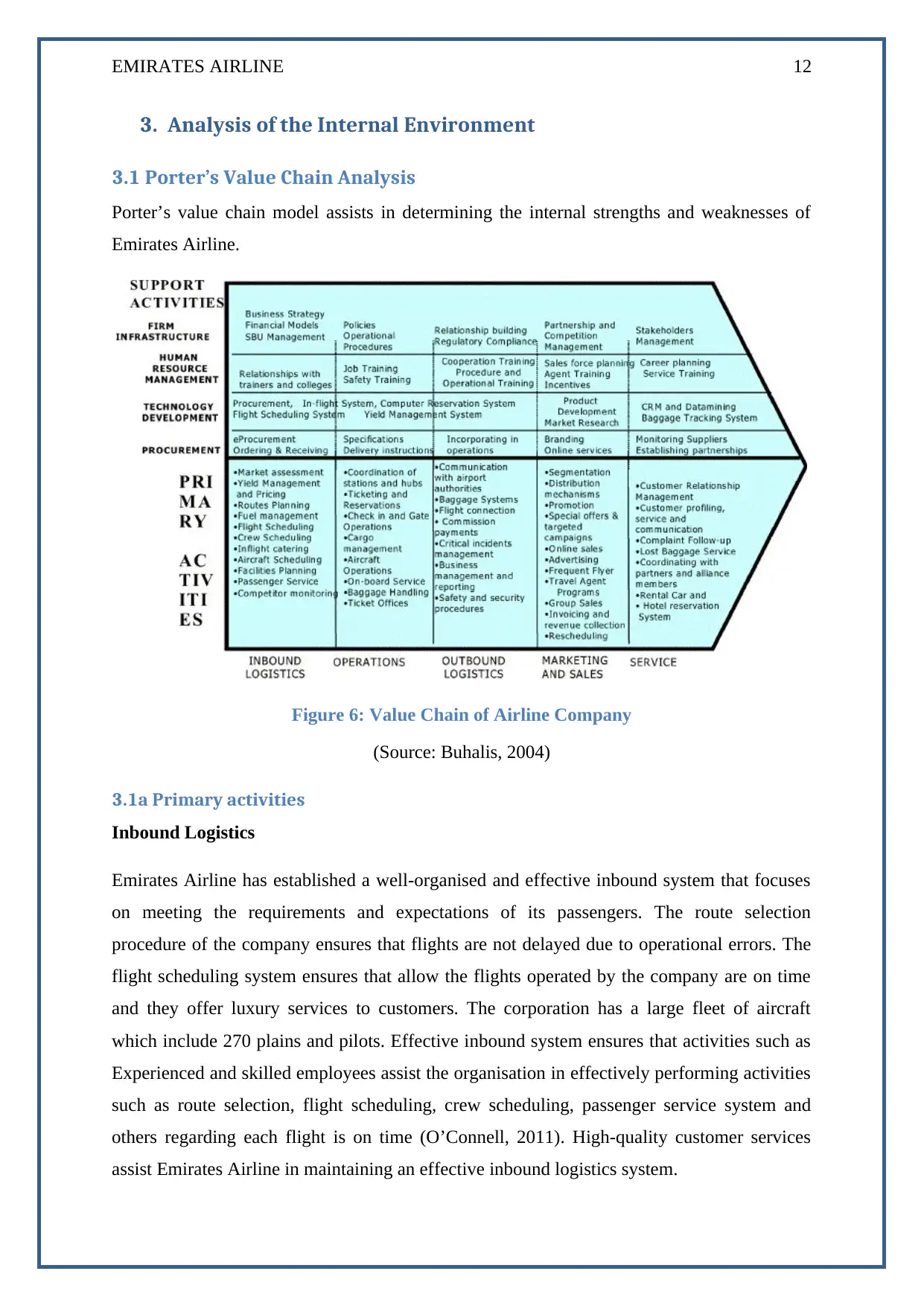
EMIRATES AIRLINE 12
3. Analysis of the Internal Environment
3.1 Porter’s Value Chain Analysis
Porter’s value chain model assists in determining the internal strengths and weaknesses of
Emirates Airline.
Figure 6: Value Chain of Airline Company
(Source: Buhalis, 2004)
3.1a Primary activities
Inbound Logistics
Emirates Airline has established a well-organised and effective inbound system that focuses
on meeting the requirements and expectations of its passengers. The route selection
procedure of the company ensures that flights are not delayed due to operational errors. The
flight scheduling system ensures that allow the flights operated by the company are on time
and they offer luxury services to customers. The corporation has a large fleet of aircraft
which include 270 plains and pilots. Effective inbound system ensures that activities such as
Experienced and skilled employees assist the organisation in effectively performing activities
such as route selection, flight scheduling, crew scheduling, passenger service system and
others regarding each flight is on time (O’Connell, 2011). High-quality customer services
assist Emirates Airline in maintaining an effective inbound logistics system.
3. Analysis of the Internal Environment
3.1 Porter’s Value Chain Analysis
Porter’s value chain model assists in determining the internal strengths and weaknesses of
Emirates Airline.
Figure 6: Value Chain of Airline Company
(Source: Buhalis, 2004)
3.1a Primary activities
Inbound Logistics
Emirates Airline has established a well-organised and effective inbound system that focuses
on meeting the requirements and expectations of its passengers. The route selection
procedure of the company ensures that flights are not delayed due to operational errors. The
flight scheduling system ensures that allow the flights operated by the company are on time
and they offer luxury services to customers. The corporation has a large fleet of aircraft
which include 270 plains and pilots. Effective inbound system ensures that activities such as
Experienced and skilled employees assist the organisation in effectively performing activities
such as route selection, flight scheduling, crew scheduling, passenger service system and
others regarding each flight is on time (O’Connell, 2011). High-quality customer services
assist Emirates Airline in maintaining an effective inbound logistics system.
Paraphrase This Document
Need a fresh take? Get an instant paraphrase of this document with our AI Paraphraser
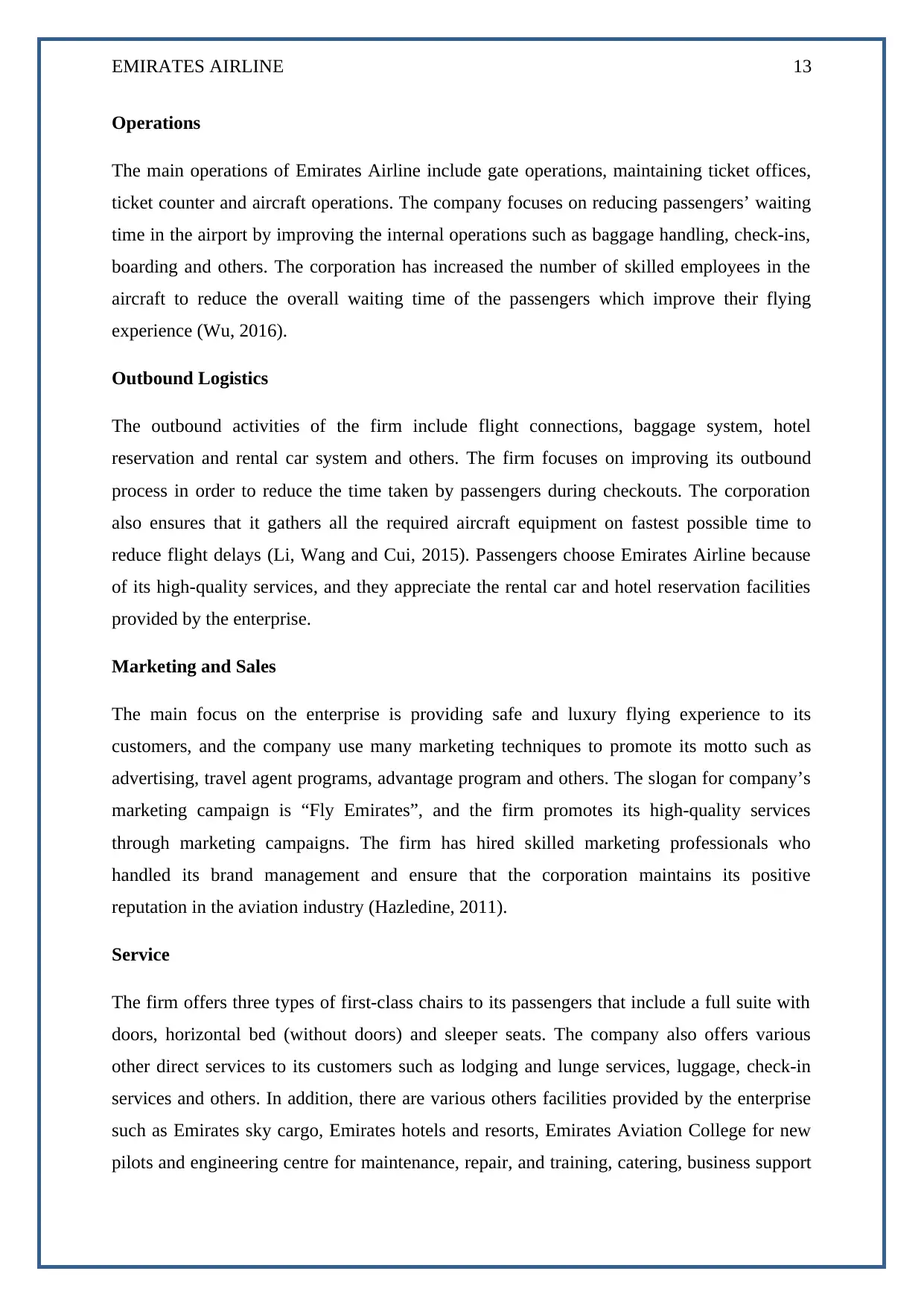
EMIRATES AIRLINE 13
Operations
The main operations of Emirates Airline include gate operations, maintaining ticket offices,
ticket counter and aircraft operations. The company focuses on reducing passengers’ waiting
time in the airport by improving the internal operations such as baggage handling, check-ins,
boarding and others. The corporation has increased the number of skilled employees in the
aircraft to reduce the overall waiting time of the passengers which improve their flying
experience (Wu, 2016).
Outbound Logistics
The outbound activities of the firm include flight connections, baggage system, hotel
reservation and rental car system and others. The firm focuses on improving its outbound
process in order to reduce the time taken by passengers during checkouts. The corporation
also ensures that it gathers all the required aircraft equipment on fastest possible time to
reduce flight delays (Li, Wang and Cui, 2015). Passengers choose Emirates Airline because
of its high-quality services, and they appreciate the rental car and hotel reservation facilities
provided by the enterprise.
Marketing and Sales
The main focus on the enterprise is providing safe and luxury flying experience to its
customers, and the company use many marketing techniques to promote its motto such as
advertising, travel agent programs, advantage program and others. The slogan for company’s
marketing campaign is “Fly Emirates”, and the firm promotes its high-quality services
through marketing campaigns. The firm has hired skilled marketing professionals who
handled its brand management and ensure that the corporation maintains its positive
reputation in the aviation industry (Hazledine, 2011).
Service
The firm offers three types of first-class chairs to its passengers that include a full suite with
doors, horizontal bed (without doors) and sleeper seats. The company also offers various
other direct services to its customers such as lodging and lunge services, luggage, check-in
services and others. In addition, there are various others facilities provided by the enterprise
such as Emirates sky cargo, Emirates hotels and resorts, Emirates Aviation College for new
pilots and engineering centre for maintenance, repair, and training, catering, business support
Operations
The main operations of Emirates Airline include gate operations, maintaining ticket offices,
ticket counter and aircraft operations. The company focuses on reducing passengers’ waiting
time in the airport by improving the internal operations such as baggage handling, check-ins,
boarding and others. The corporation has increased the number of skilled employees in the
aircraft to reduce the overall waiting time of the passengers which improve their flying
experience (Wu, 2016).
Outbound Logistics
The outbound activities of the firm include flight connections, baggage system, hotel
reservation and rental car system and others. The firm focuses on improving its outbound
process in order to reduce the time taken by passengers during checkouts. The corporation
also ensures that it gathers all the required aircraft equipment on fastest possible time to
reduce flight delays (Li, Wang and Cui, 2015). Passengers choose Emirates Airline because
of its high-quality services, and they appreciate the rental car and hotel reservation facilities
provided by the enterprise.
Marketing and Sales
The main focus on the enterprise is providing safe and luxury flying experience to its
customers, and the company use many marketing techniques to promote its motto such as
advertising, travel agent programs, advantage program and others. The slogan for company’s
marketing campaign is “Fly Emirates”, and the firm promotes its high-quality services
through marketing campaigns. The firm has hired skilled marketing professionals who
handled its brand management and ensure that the corporation maintains its positive
reputation in the aviation industry (Hazledine, 2011).
Service
The firm offers three types of first-class chairs to its passengers that include a full suite with
doors, horizontal bed (without doors) and sleeper seats. The company also offers various
other direct services to its customers such as lodging and lunge services, luggage, check-in
services and others. In addition, there are various others facilities provided by the enterprise
such as Emirates sky cargo, Emirates hotels and resorts, Emirates Aviation College for new
pilots and engineering centre for maintenance, repair, and training, catering, business support
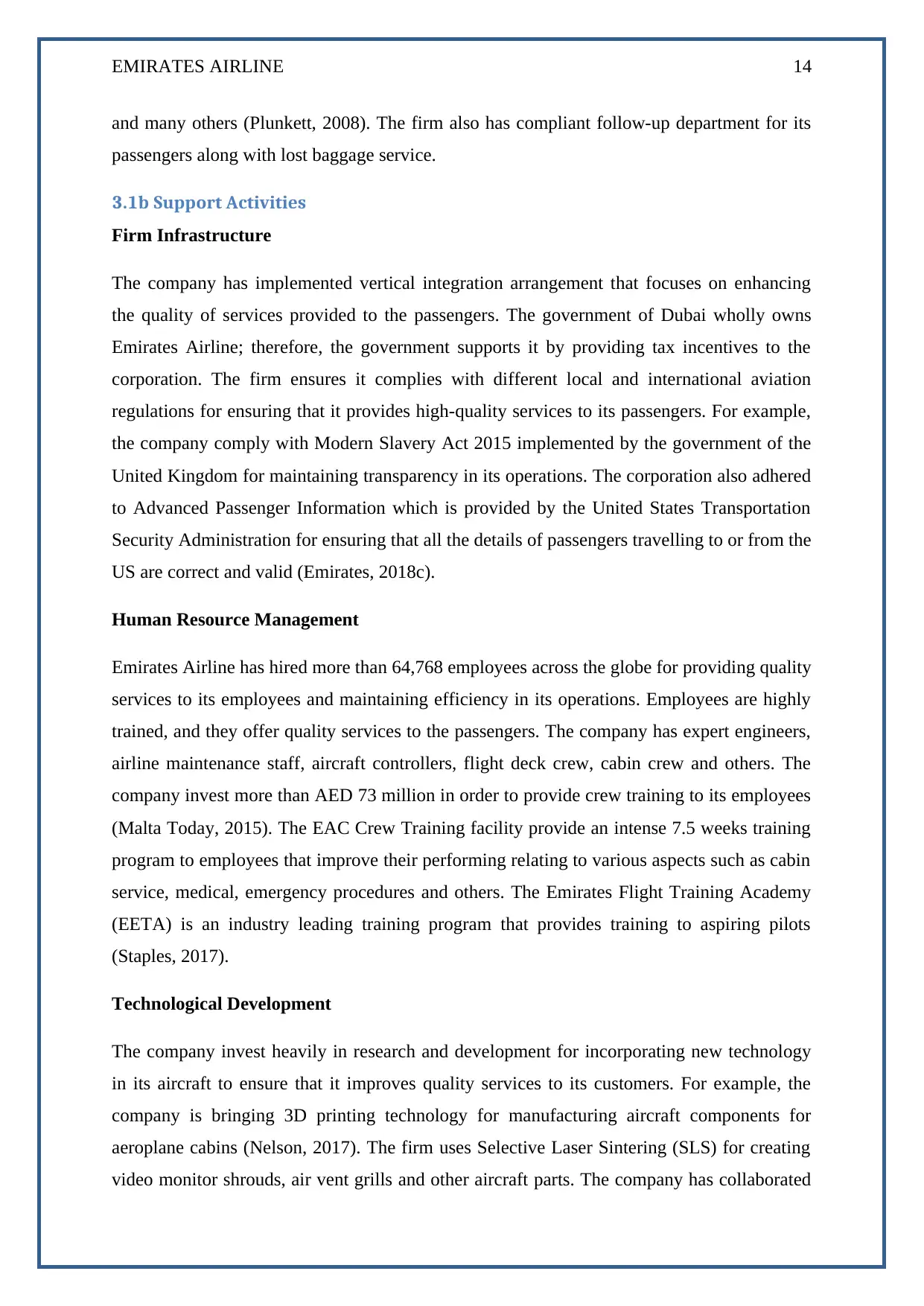
EMIRATES AIRLINE 14
and many others (Plunkett, 2008). The firm also has compliant follow-up department for its
passengers along with lost baggage service.
3.1b Support Activities
Firm Infrastructure
The company has implemented vertical integration arrangement that focuses on enhancing
the quality of services provided to the passengers. The government of Dubai wholly owns
Emirates Airline; therefore, the government supports it by providing tax incentives to the
corporation. The firm ensures it complies with different local and international aviation
regulations for ensuring that it provides high-quality services to its passengers. For example,
the company comply with Modern Slavery Act 2015 implemented by the government of the
United Kingdom for maintaining transparency in its operations. The corporation also adhered
to Advanced Passenger Information which is provided by the United States Transportation
Security Administration for ensuring that all the details of passengers travelling to or from the
US are correct and valid (Emirates, 2018c).
Human Resource Management
Emirates Airline has hired more than 64,768 employees across the globe for providing quality
services to its employees and maintaining efficiency in its operations. Employees are highly
trained, and they offer quality services to the passengers. The company has expert engineers,
airline maintenance staff, aircraft controllers, flight deck crew, cabin crew and others. The
company invest more than AED 73 million in order to provide crew training to its employees
(Malta Today, 2015). The EAC Crew Training facility provide an intense 7.5 weeks training
program to employees that improve their performing relating to various aspects such as cabin
service, medical, emergency procedures and others. The Emirates Flight Training Academy
(EETA) is an industry leading training program that provides training to aspiring pilots
(Staples, 2017).
Technological Development
The company invest heavily in research and development for incorporating new technology
in its aircraft to ensure that it improves quality services to its customers. For example, the
company is bringing 3D printing technology for manufacturing aircraft components for
aeroplane cabins (Nelson, 2017). The firm uses Selective Laser Sintering (SLS) for creating
video monitor shrouds, air vent grills and other aircraft parts. The company has collaborated
and many others (Plunkett, 2008). The firm also has compliant follow-up department for its
passengers along with lost baggage service.
3.1b Support Activities
Firm Infrastructure
The company has implemented vertical integration arrangement that focuses on enhancing
the quality of services provided to the passengers. The government of Dubai wholly owns
Emirates Airline; therefore, the government supports it by providing tax incentives to the
corporation. The firm ensures it complies with different local and international aviation
regulations for ensuring that it provides high-quality services to its passengers. For example,
the company comply with Modern Slavery Act 2015 implemented by the government of the
United Kingdom for maintaining transparency in its operations. The corporation also adhered
to Advanced Passenger Information which is provided by the United States Transportation
Security Administration for ensuring that all the details of passengers travelling to or from the
US are correct and valid (Emirates, 2018c).
Human Resource Management
Emirates Airline has hired more than 64,768 employees across the globe for providing quality
services to its employees and maintaining efficiency in its operations. Employees are highly
trained, and they offer quality services to the passengers. The company has expert engineers,
airline maintenance staff, aircraft controllers, flight deck crew, cabin crew and others. The
company invest more than AED 73 million in order to provide crew training to its employees
(Malta Today, 2015). The EAC Crew Training facility provide an intense 7.5 weeks training
program to employees that improve their performing relating to various aspects such as cabin
service, medical, emergency procedures and others. The Emirates Flight Training Academy
(EETA) is an industry leading training program that provides training to aspiring pilots
(Staples, 2017).
Technological Development
The company invest heavily in research and development for incorporating new technology
in its aircraft to ensure that it improves quality services to its customers. For example, the
company is bringing 3D printing technology for manufacturing aircraft components for
aeroplane cabins (Nelson, 2017). The firm uses Selective Laser Sintering (SLS) for creating
video monitor shrouds, air vent grills and other aircraft parts. The company has collaborated
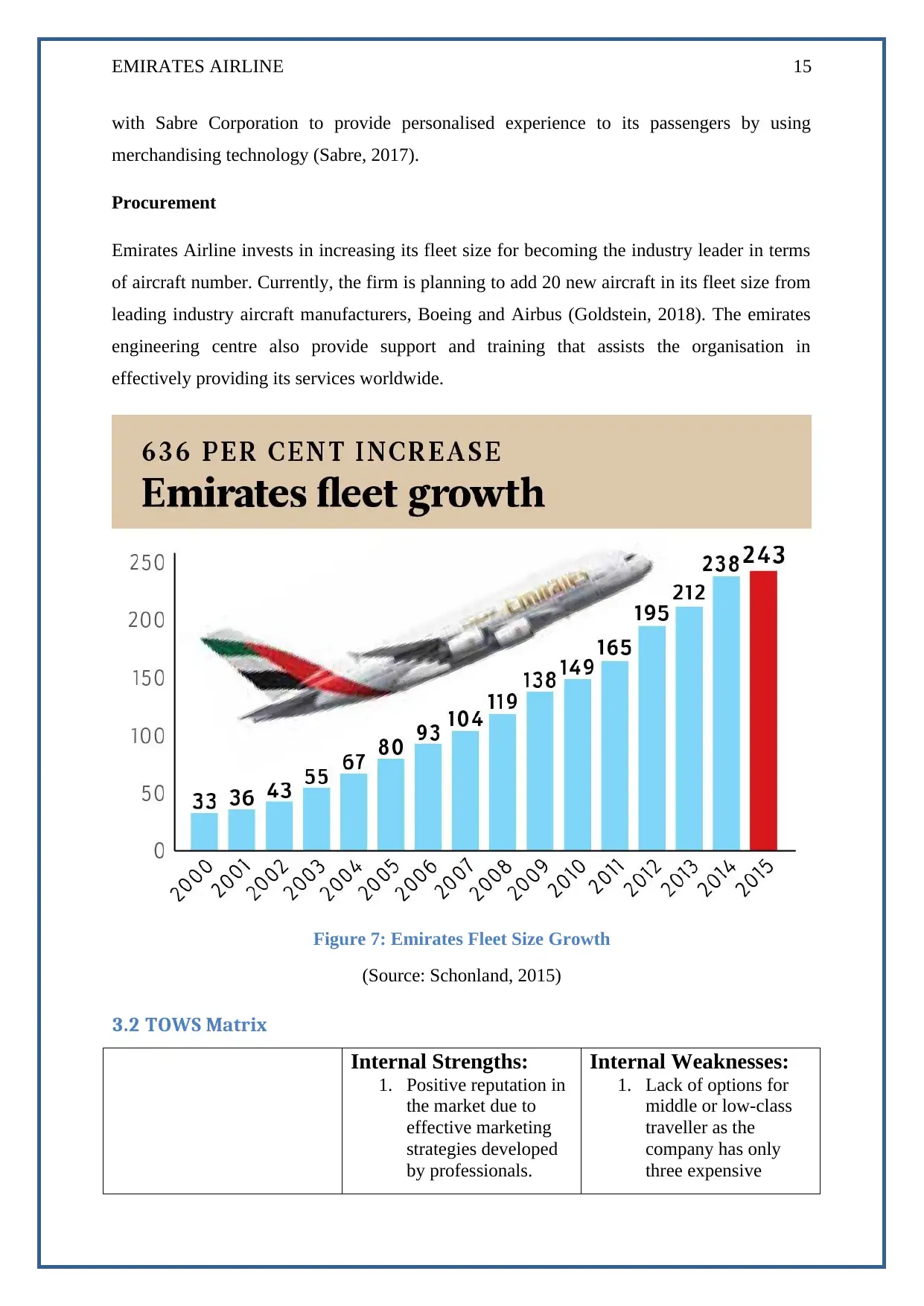
EMIRATES AIRLINE 15
with Sabre Corporation to provide personalised experience to its passengers by using
merchandising technology (Sabre, 2017).
Procurement
Emirates Airline invests in increasing its fleet size for becoming the industry leader in terms
of aircraft number. Currently, the firm is planning to add 20 new aircraft in its fleet size from
leading industry aircraft manufacturers, Boeing and Airbus (Goldstein, 2018). The emirates
engineering centre also provide support and training that assists the organisation in
effectively providing its services worldwide.
Figure 7: Emirates Fleet Size Growth
(Source: Schonland, 2015)
3.2 TOWS Matrix
Internal Strengths:
1. Positive reputation in
the market due to
effective marketing
strategies developed
by professionals.
Internal Weaknesses:
1. Lack of options for
middle or low-class
traveller as the
company has only
three expensive
with Sabre Corporation to provide personalised experience to its passengers by using
merchandising technology (Sabre, 2017).
Procurement
Emirates Airline invests in increasing its fleet size for becoming the industry leader in terms
of aircraft number. Currently, the firm is planning to add 20 new aircraft in its fleet size from
leading industry aircraft manufacturers, Boeing and Airbus (Goldstein, 2018). The emirates
engineering centre also provide support and training that assists the organisation in
effectively providing its services worldwide.
Figure 7: Emirates Fleet Size Growth
(Source: Schonland, 2015)
3.2 TOWS Matrix
Internal Strengths:
1. Positive reputation in
the market due to
effective marketing
strategies developed
by professionals.
Internal Weaknesses:
1. Lack of options for
middle or low-class
traveller as the
company has only
three expensive
Secure Best Marks with AI Grader
Need help grading? Try our AI Grader for instant feedback on your assignments.
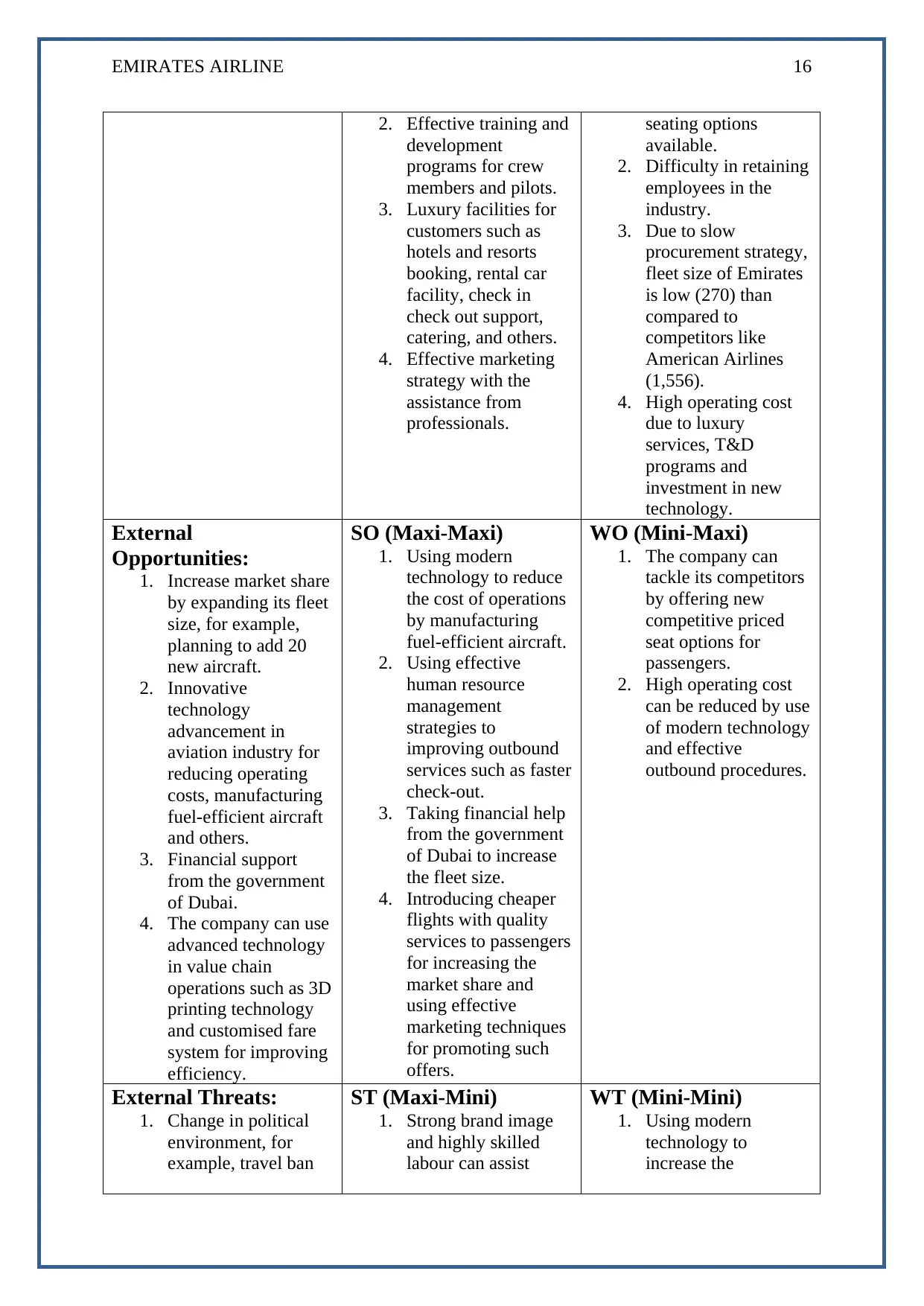
EMIRATES AIRLINE 16
2. Effective training and
development
programs for crew
members and pilots.
3. Luxury facilities for
customers such as
hotels and resorts
booking, rental car
facility, check in
check out support,
catering, and others.
4. Effective marketing
strategy with the
assistance from
professionals.
seating options
available.
2. Difficulty in retaining
employees in the
industry.
3. Due to slow
procurement strategy,
fleet size of Emirates
is low (270) than
compared to
competitors like
American Airlines
(1,556).
4. High operating cost
due to luxury
services, T&D
programs and
investment in new
technology.
External
Opportunities:
1. Increase market share
by expanding its fleet
size, for example,
planning to add 20
new aircraft.
2. Innovative
technology
advancement in
aviation industry for
reducing operating
costs, manufacturing
fuel-efficient aircraft
and others.
3. Financial support
from the government
of Dubai.
4. The company can use
advanced technology
in value chain
operations such as 3D
printing technology
and customised fare
system for improving
efficiency.
SO (Maxi-Maxi)
1. Using modern
technology to reduce
the cost of operations
by manufacturing
fuel-efficient aircraft.
2. Using effective
human resource
management
strategies to
improving outbound
services such as faster
check-out.
3. Taking financial help
from the government
of Dubai to increase
the fleet size.
4. Introducing cheaper
flights with quality
services to passengers
for increasing the
market share and
using effective
marketing techniques
for promoting such
offers.
WO (Mini-Maxi)
1. The company can
tackle its competitors
by offering new
competitive priced
seat options for
passengers.
2. High operating cost
can be reduced by use
of modern technology
and effective
outbound procedures.
External Threats:
1. Change in political
environment, for
example, travel ban
ST (Maxi-Mini)
1. Strong brand image
and highly skilled
labour can assist
WT (Mini-Mini)
1. Using modern
technology to
increase the
2. Effective training and
development
programs for crew
members and pilots.
3. Luxury facilities for
customers such as
hotels and resorts
booking, rental car
facility, check in
check out support,
catering, and others.
4. Effective marketing
strategy with the
assistance from
professionals.
seating options
available.
2. Difficulty in retaining
employees in the
industry.
3. Due to slow
procurement strategy,
fleet size of Emirates
is low (270) than
compared to
competitors like
American Airlines
(1,556).
4. High operating cost
due to luxury
services, T&D
programs and
investment in new
technology.
External
Opportunities:
1. Increase market share
by expanding its fleet
size, for example,
planning to add 20
new aircraft.
2. Innovative
technology
advancement in
aviation industry for
reducing operating
costs, manufacturing
fuel-efficient aircraft
and others.
3. Financial support
from the government
of Dubai.
4. The company can use
advanced technology
in value chain
operations such as 3D
printing technology
and customised fare
system for improving
efficiency.
SO (Maxi-Maxi)
1. Using modern
technology to reduce
the cost of operations
by manufacturing
fuel-efficient aircraft.
2. Using effective
human resource
management
strategies to
improving outbound
services such as faster
check-out.
3. Taking financial help
from the government
of Dubai to increase
the fleet size.
4. Introducing cheaper
flights with quality
services to passengers
for increasing the
market share and
using effective
marketing techniques
for promoting such
offers.
WO (Mini-Maxi)
1. The company can
tackle its competitors
by offering new
competitive priced
seat options for
passengers.
2. High operating cost
can be reduced by use
of modern technology
and effective
outbound procedures.
External Threats:
1. Change in political
environment, for
example, travel ban
ST (Maxi-Mini)
1. Strong brand image
and highly skilled
labour can assist
WT (Mini-Mini)
1. Using modern
technology to
increase the
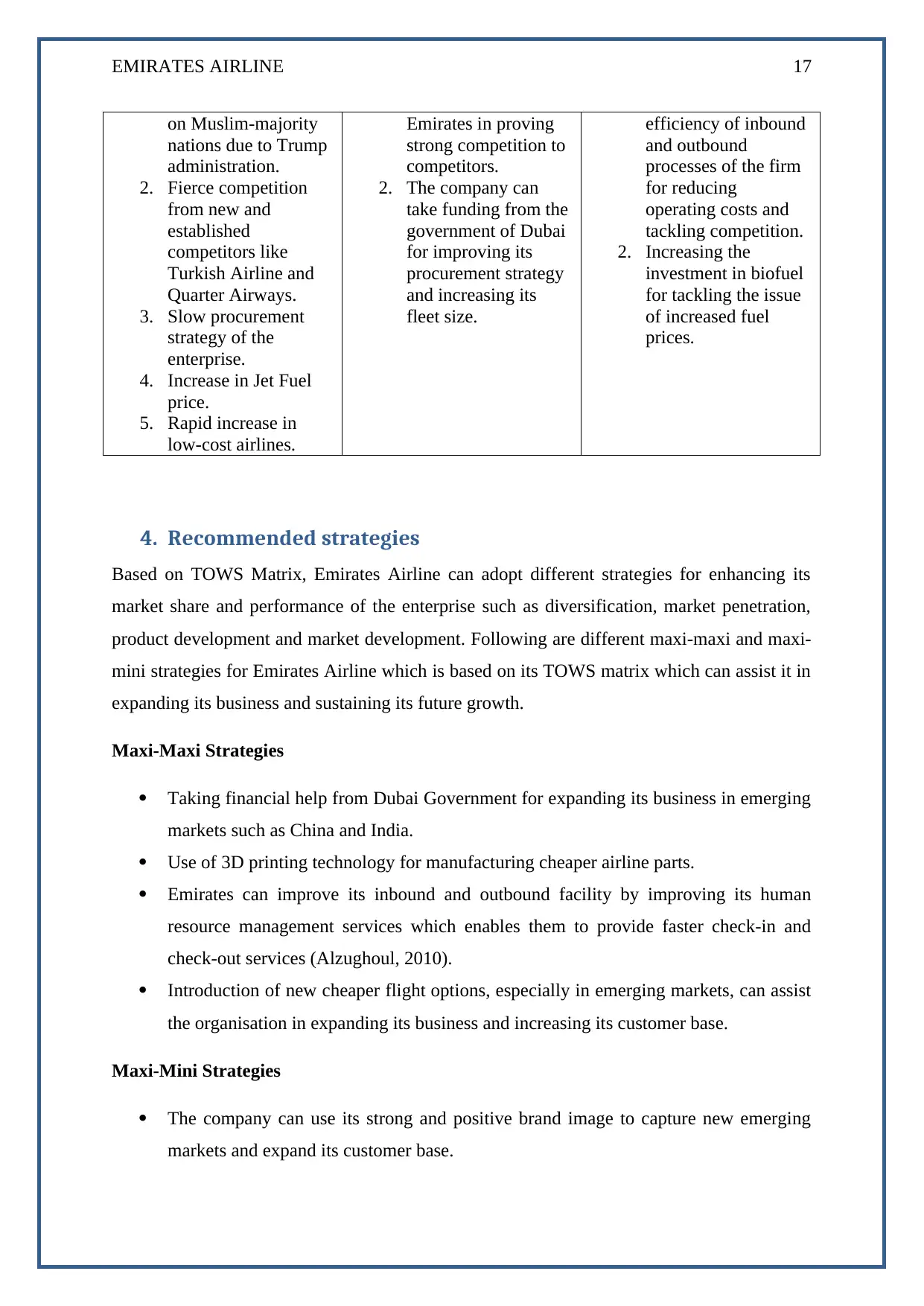
EMIRATES AIRLINE 17
on Muslim-majority
nations due to Trump
administration.
2. Fierce competition
from new and
established
competitors like
Turkish Airline and
Quarter Airways.
3. Slow procurement
strategy of the
enterprise.
4. Increase in Jet Fuel
price.
5. Rapid increase in
low-cost airlines.
Emirates in proving
strong competition to
competitors.
2. The company can
take funding from the
government of Dubai
for improving its
procurement strategy
and increasing its
fleet size.
efficiency of inbound
and outbound
processes of the firm
for reducing
operating costs and
tackling competition.
2. Increasing the
investment in biofuel
for tackling the issue
of increased fuel
prices.
4. Recommended strategies
Based on TOWS Matrix, Emirates Airline can adopt different strategies for enhancing its
market share and performance of the enterprise such as diversification, market penetration,
product development and market development. Following are different maxi-maxi and maxi-
mini strategies for Emirates Airline which is based on its TOWS matrix which can assist it in
expanding its business and sustaining its future growth.
Maxi-Maxi Strategies
Taking financial help from Dubai Government for expanding its business in emerging
markets such as China and India.
Use of 3D printing technology for manufacturing cheaper airline parts.
Emirates can improve its inbound and outbound facility by improving its human
resource management services which enables them to provide faster check-in and
check-out services (Alzughoul, 2010).
Introduction of new cheaper flight options, especially in emerging markets, can assist
the organisation in expanding its business and increasing its customer base.
Maxi-Mini Strategies
The company can use its strong and positive brand image to capture new emerging
markets and expand its customer base.
on Muslim-majority
nations due to Trump
administration.
2. Fierce competition
from new and
established
competitors like
Turkish Airline and
Quarter Airways.
3. Slow procurement
strategy of the
enterprise.
4. Increase in Jet Fuel
price.
5. Rapid increase in
low-cost airlines.
Emirates in proving
strong competition to
competitors.
2. The company can
take funding from the
government of Dubai
for improving its
procurement strategy
and increasing its
fleet size.
efficiency of inbound
and outbound
processes of the firm
for reducing
operating costs and
tackling competition.
2. Increasing the
investment in biofuel
for tackling the issue
of increased fuel
prices.
4. Recommended strategies
Based on TOWS Matrix, Emirates Airline can adopt different strategies for enhancing its
market share and performance of the enterprise such as diversification, market penetration,
product development and market development. Following are different maxi-maxi and maxi-
mini strategies for Emirates Airline which is based on its TOWS matrix which can assist it in
expanding its business and sustaining its future growth.
Maxi-Maxi Strategies
Taking financial help from Dubai Government for expanding its business in emerging
markets such as China and India.
Use of 3D printing technology for manufacturing cheaper airline parts.
Emirates can improve its inbound and outbound facility by improving its human
resource management services which enables them to provide faster check-in and
check-out services (Alzughoul, 2010).
Introduction of new cheaper flight options, especially in emerging markets, can assist
the organisation in expanding its business and increasing its customer base.
Maxi-Mini Strategies
The company can use its strong and positive brand image to capture new emerging
markets and expand its customer base.
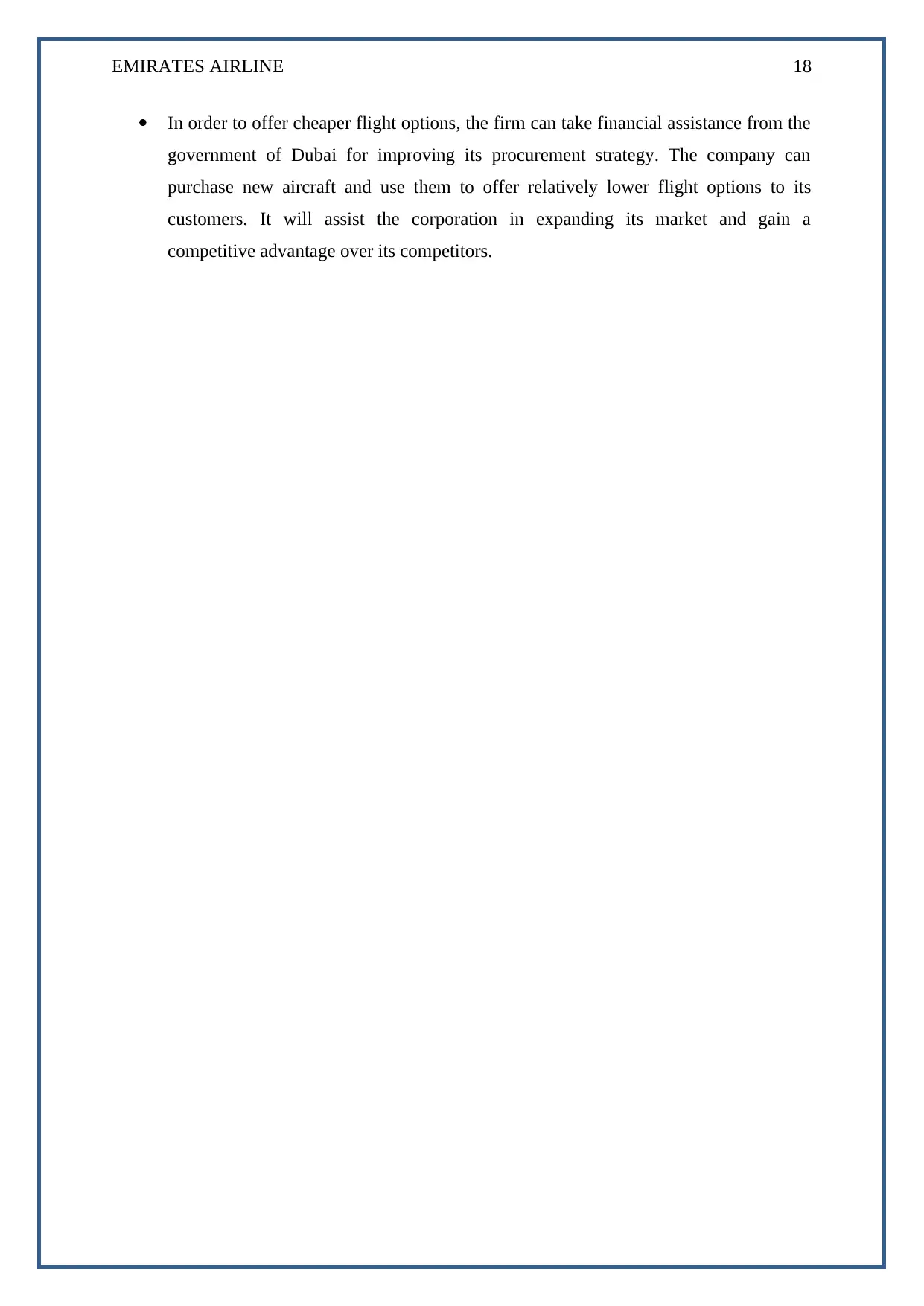
EMIRATES AIRLINE 18
In order to offer cheaper flight options, the firm can take financial assistance from the
government of Dubai for improving its procurement strategy. The company can
purchase new aircraft and use them to offer relatively lower flight options to its
customers. It will assist the corporation in expanding its market and gain a
competitive advantage over its competitors.
In order to offer cheaper flight options, the firm can take financial assistance from the
government of Dubai for improving its procurement strategy. The company can
purchase new aircraft and use them to offer relatively lower flight options to its
customers. It will assist the corporation in expanding its market and gain a
competitive advantage over its competitors.
Paraphrase This Document
Need a fresh take? Get an instant paraphrase of this document with our AI Paraphraser

EMIRATES AIRLINE 19
5. Conclusion
In conclusion, Emirates Airline is one of the leading airline firms which offer luxury services
to its passengers. The corporation focuses on providing safe and luxury flying experience to
its passengers. The company is facing various issues such as fierce competition, increased
fuel prices, and changing political environment. Porter’s five force and PEST analysis were
conducted in the report for evaluating different factors that affect the company’s business
such as suppliers’ bargaining power, increase in number of low-cost flights, rapid changes in
technology and others. Emirates Airline has established an effective value chain framework
that focuses on providing quality services to passengers and increasing efficiency of
operations. High competition, increasing fuel prices, changing technology and unstable
political environment require the organisation to revamp its business strategies. The firm can
offer low-cost flight options to increase its customer base; expand its fleet size by taking
financial help from Dubai’s government. It can use the latest technology for improving the
fuel efficiency of aircraft and implement effective marketing strategy for increasing its
market share. These strategies can assist Emirates Airline in expanding its market and
sustaining its future growth.
5. Conclusion
In conclusion, Emirates Airline is one of the leading airline firms which offer luxury services
to its passengers. The corporation focuses on providing safe and luxury flying experience to
its passengers. The company is facing various issues such as fierce competition, increased
fuel prices, and changing political environment. Porter’s five force and PEST analysis were
conducted in the report for evaluating different factors that affect the company’s business
such as suppliers’ bargaining power, increase in number of low-cost flights, rapid changes in
technology and others. Emirates Airline has established an effective value chain framework
that focuses on providing quality services to passengers and increasing efficiency of
operations. High competition, increasing fuel prices, changing technology and unstable
political environment require the organisation to revamp its business strategies. The firm can
offer low-cost flight options to increase its customer base; expand its fleet size by taking
financial help from Dubai’s government. It can use the latest technology for improving the
fuel efficiency of aircraft and implement effective marketing strategy for increasing its
market share. These strategies can assist Emirates Airline in expanding its market and
sustaining its future growth.
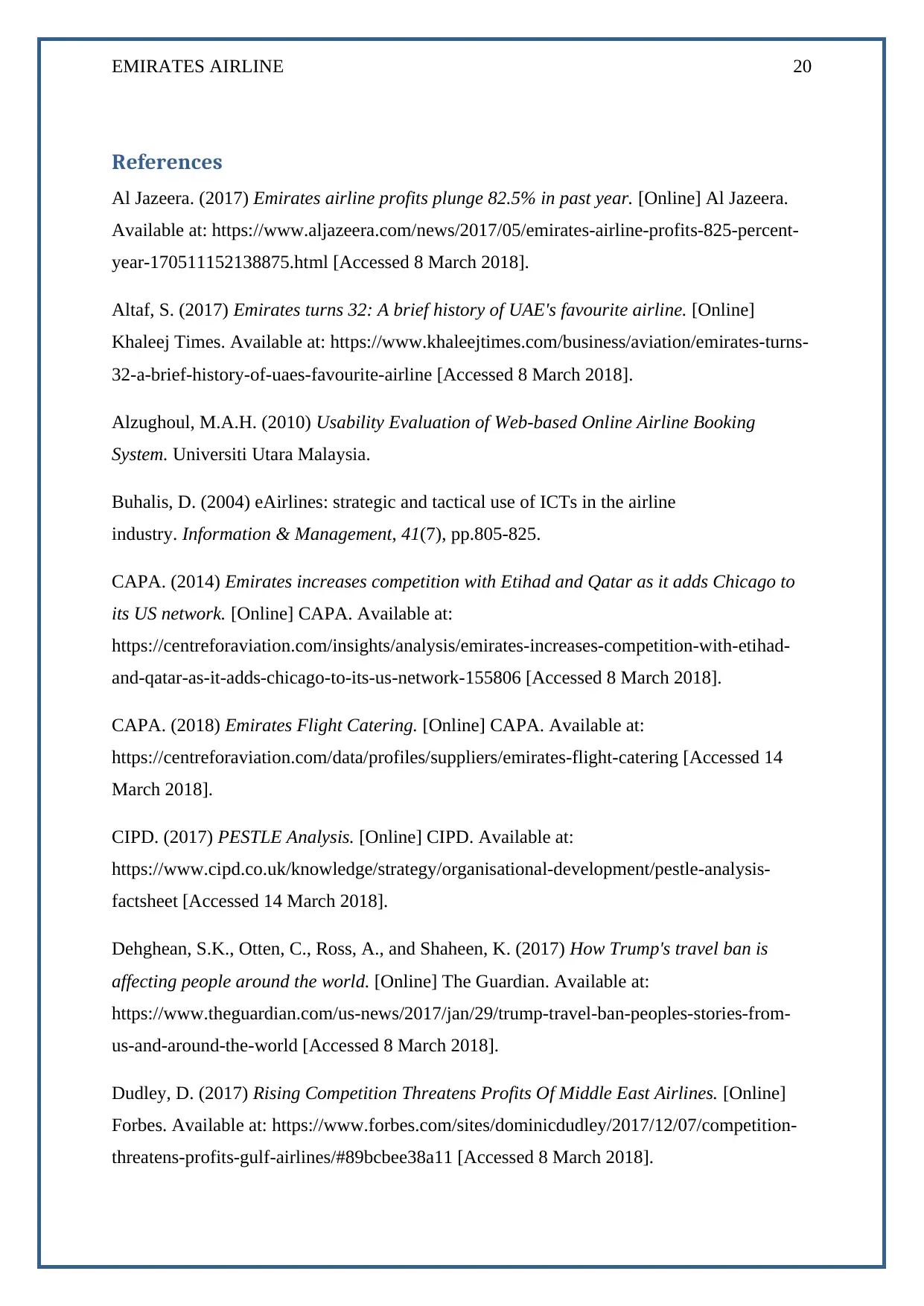
EMIRATES AIRLINE 20
References
Al Jazeera. (2017) Emirates airline profits plunge 82.5% in past year. [Online] Al Jazeera.
Available at: https://www.aljazeera.com/news/2017/05/emirates-airline-profits-825-percent-
year-170511152138875.html [Accessed 8 March 2018].
Altaf, S. (2017) Emirates turns 32: A brief history of UAE's favourite airline. [Online]
Khaleej Times. Available at: https://www.khaleejtimes.com/business/aviation/emirates-turns-
32-a-brief-history-of-uaes-favourite-airline [Accessed 8 March 2018].
Alzughoul, M.A.H. (2010) Usability Evaluation of Web-based Online Airline Booking
System. Universiti Utara Malaysia.
Buhalis, D. (2004) eAirlines: strategic and tactical use of ICTs in the airline
industry. Information & Management, 41(7), pp.805-825.
CAPA. (2014) Emirates increases competition with Etihad and Qatar as it adds Chicago to
its US network. [Online] CAPA. Available at:
https://centreforaviation.com/insights/analysis/emirates-increases-competition-with-etihad-
and-qatar-as-it-adds-chicago-to-its-us-network-155806 [Accessed 8 March 2018].
CAPA. (2018) Emirates Flight Catering. [Online] CAPA. Available at:
https://centreforaviation.com/data/profiles/suppliers/emirates-flight-catering [Accessed 14
March 2018].
CIPD. (2017) PESTLE Analysis. [Online] CIPD. Available at:
https://www.cipd.co.uk/knowledge/strategy/organisational-development/pestle-analysis-
factsheet [Accessed 14 March 2018].
Dehghean, S.K., Otten, C., Ross, A., and Shaheen, K. (2017) How Trump's travel ban is
affecting people around the world. [Online] The Guardian. Available at:
https://www.theguardian.com/us-news/2017/jan/29/trump-travel-ban-peoples-stories-from-
us-and-around-the-world [Accessed 8 March 2018].
Dudley, D. (2017) Rising Competition Threatens Profits Of Middle East Airlines. [Online]
Forbes. Available at: https://www.forbes.com/sites/dominicdudley/2017/12/07/competition-
threatens-profits-gulf-airlines/#89bcbee38a11 [Accessed 8 March 2018].
References
Al Jazeera. (2017) Emirates airline profits plunge 82.5% in past year. [Online] Al Jazeera.
Available at: https://www.aljazeera.com/news/2017/05/emirates-airline-profits-825-percent-
year-170511152138875.html [Accessed 8 March 2018].
Altaf, S. (2017) Emirates turns 32: A brief history of UAE's favourite airline. [Online]
Khaleej Times. Available at: https://www.khaleejtimes.com/business/aviation/emirates-turns-
32-a-brief-history-of-uaes-favourite-airline [Accessed 8 March 2018].
Alzughoul, M.A.H. (2010) Usability Evaluation of Web-based Online Airline Booking
System. Universiti Utara Malaysia.
Buhalis, D. (2004) eAirlines: strategic and tactical use of ICTs in the airline
industry. Information & Management, 41(7), pp.805-825.
CAPA. (2014) Emirates increases competition with Etihad and Qatar as it adds Chicago to
its US network. [Online] CAPA. Available at:
https://centreforaviation.com/insights/analysis/emirates-increases-competition-with-etihad-
and-qatar-as-it-adds-chicago-to-its-us-network-155806 [Accessed 8 March 2018].
CAPA. (2018) Emirates Flight Catering. [Online] CAPA. Available at:
https://centreforaviation.com/data/profiles/suppliers/emirates-flight-catering [Accessed 14
March 2018].
CIPD. (2017) PESTLE Analysis. [Online] CIPD. Available at:
https://www.cipd.co.uk/knowledge/strategy/organisational-development/pestle-analysis-
factsheet [Accessed 14 March 2018].
Dehghean, S.K., Otten, C., Ross, A., and Shaheen, K. (2017) How Trump's travel ban is
affecting people around the world. [Online] The Guardian. Available at:
https://www.theguardian.com/us-news/2017/jan/29/trump-travel-ban-peoples-stories-from-
us-and-around-the-world [Accessed 8 March 2018].
Dudley, D. (2017) Rising Competition Threatens Profits Of Middle East Airlines. [Online]
Forbes. Available at: https://www.forbes.com/sites/dominicdudley/2017/12/07/competition-
threatens-profits-gulf-airlines/#89bcbee38a11 [Accessed 8 March 2018].
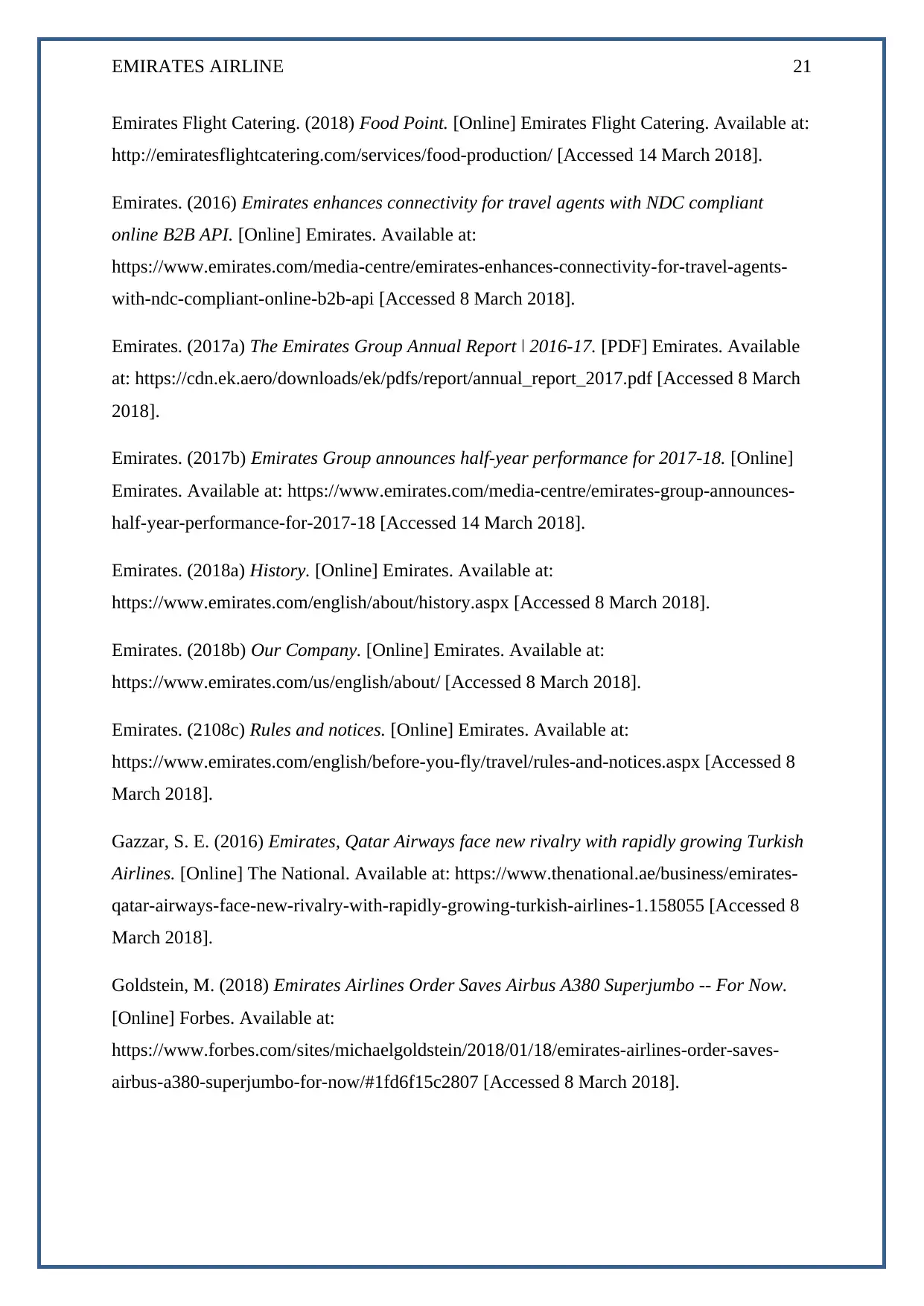
EMIRATES AIRLINE 21
Emirates Flight Catering. (2018) Food Point. [Online] Emirates Flight Catering. Available at:
http://emiratesflightcatering.com/services/food-production/ [Accessed 14 March 2018].
Emirates. (2016) Emirates enhances connectivity for travel agents with NDC compliant
online B2B API. [Online] Emirates. Available at:
https://www.emirates.com/media-centre/emirates-enhances-connectivity-for-travel-agents-
with-ndc-compliant-online-b2b-api [Accessed 8 March 2018].
Emirates. (2017a) The Emirates Group Annual Report ǀ 2016-17. [PDF] Emirates. Available
at: https://cdn.ek.aero/downloads/ek/pdfs/report/annual_report_2017.pdf [Accessed 8 March
2018].
Emirates. (2017b) Emirates Group announces half-year performance for 2017-18. [Online]
Emirates. Available at: https://www.emirates.com/media-centre/emirates-group-announces-
half-year-performance-for-2017-18 [Accessed 14 March 2018].
Emirates. (2018a) History. [Online] Emirates. Available at:
https://www.emirates.com/english/about/history.aspx [Accessed 8 March 2018].
Emirates. (2018b) Our Company. [Online] Emirates. Available at:
https://www.emirates.com/us/english/about/ [Accessed 8 March 2018].
Emirates. (2108c) Rules and notices. [Online] Emirates. Available at:
https://www.emirates.com/english/before-you-fly/travel/rules-and-notices.aspx [Accessed 8
March 2018].
Gazzar, S. E. (2016) Emirates, Qatar Airways face new rivalry with rapidly growing Turkish
Airlines. [Online] The National. Available at: https://www.thenational.ae/business/emirates-
qatar-airways-face-new-rivalry-with-rapidly-growing-turkish-airlines-1.158055 [Accessed 8
March 2018].
Goldstein, M. (2018) Emirates Airlines Order Saves Airbus A380 Superjumbo -- For Now.
[Online] Forbes. Available at:
https://www.forbes.com/sites/michaelgoldstein/2018/01/18/emirates-airlines-order-saves-
airbus-a380-superjumbo-for-now/#1fd6f15c2807 [Accessed 8 March 2018].
Emirates Flight Catering. (2018) Food Point. [Online] Emirates Flight Catering. Available at:
http://emiratesflightcatering.com/services/food-production/ [Accessed 14 March 2018].
Emirates. (2016) Emirates enhances connectivity for travel agents with NDC compliant
online B2B API. [Online] Emirates. Available at:
https://www.emirates.com/media-centre/emirates-enhances-connectivity-for-travel-agents-
with-ndc-compliant-online-b2b-api [Accessed 8 March 2018].
Emirates. (2017a) The Emirates Group Annual Report ǀ 2016-17. [PDF] Emirates. Available
at: https://cdn.ek.aero/downloads/ek/pdfs/report/annual_report_2017.pdf [Accessed 8 March
2018].
Emirates. (2017b) Emirates Group announces half-year performance for 2017-18. [Online]
Emirates. Available at: https://www.emirates.com/media-centre/emirates-group-announces-
half-year-performance-for-2017-18 [Accessed 14 March 2018].
Emirates. (2018a) History. [Online] Emirates. Available at:
https://www.emirates.com/english/about/history.aspx [Accessed 8 March 2018].
Emirates. (2018b) Our Company. [Online] Emirates. Available at:
https://www.emirates.com/us/english/about/ [Accessed 8 March 2018].
Emirates. (2108c) Rules and notices. [Online] Emirates. Available at:
https://www.emirates.com/english/before-you-fly/travel/rules-and-notices.aspx [Accessed 8
March 2018].
Gazzar, S. E. (2016) Emirates, Qatar Airways face new rivalry with rapidly growing Turkish
Airlines. [Online] The National. Available at: https://www.thenational.ae/business/emirates-
qatar-airways-face-new-rivalry-with-rapidly-growing-turkish-airlines-1.158055 [Accessed 8
March 2018].
Goldstein, M. (2018) Emirates Airlines Order Saves Airbus A380 Superjumbo -- For Now.
[Online] Forbes. Available at:
https://www.forbes.com/sites/michaelgoldstein/2018/01/18/emirates-airlines-order-saves-
airbus-a380-superjumbo-for-now/#1fd6f15c2807 [Accessed 8 March 2018].
Secure Best Marks with AI Grader
Need help grading? Try our AI Grader for instant feedback on your assignments.
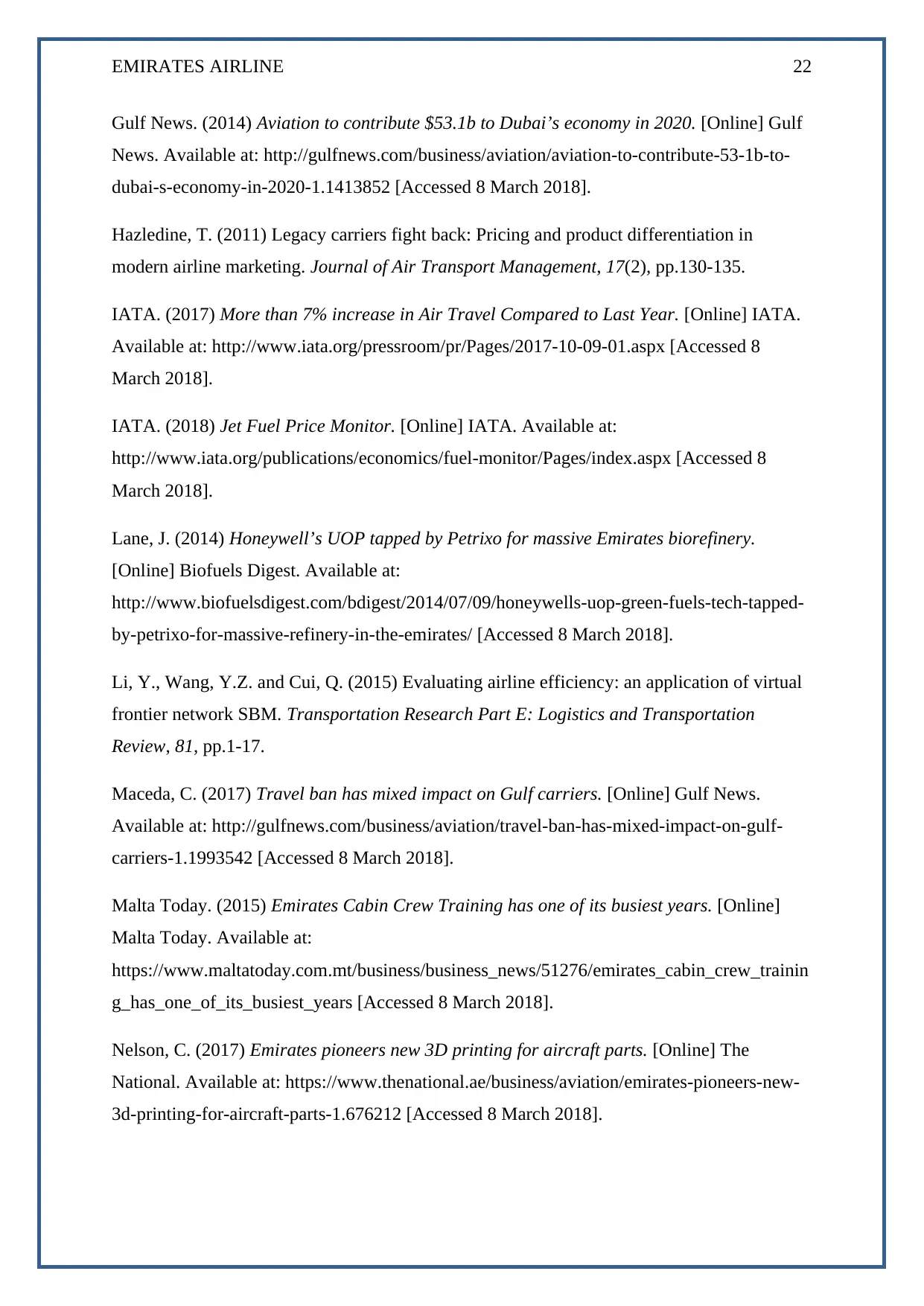
EMIRATES AIRLINE 22
Gulf News. (2014) Aviation to contribute $53.1b to Dubai’s economy in 2020. [Online] Gulf
News. Available at: http://gulfnews.com/business/aviation/aviation-to-contribute-53-1b-to-
dubai-s-economy-in-2020-1.1413852 [Accessed 8 March 2018].
Hazledine, T. (2011) Legacy carriers fight back: Pricing and product differentiation in
modern airline marketing. Journal of Air Transport Management, 17(2), pp.130-135.
IATA. (2017) More than 7% increase in Air Travel Compared to Last Year. [Online] IATA.
Available at: http://www.iata.org/pressroom/pr/Pages/2017-10-09-01.aspx [Accessed 8
March 2018].
IATA. (2018) Jet Fuel Price Monitor. [Online] IATA. Available at:
http://www.iata.org/publications/economics/fuel-monitor/Pages/index.aspx [Accessed 8
March 2018].
Lane, J. (2014) Honeywell’s UOP tapped by Petrixo for massive Emirates biorefinery.
[Online] Biofuels Digest. Available at:
http://www.biofuelsdigest.com/bdigest/2014/07/09/honeywells-uop-green-fuels-tech-tapped-
by-petrixo-for-massive-refinery-in-the-emirates/ [Accessed 8 March 2018].
Li, Y., Wang, Y.Z. and Cui, Q. (2015) Evaluating airline efficiency: an application of virtual
frontier network SBM. Transportation Research Part E: Logistics and Transportation
Review, 81, pp.1-17.
Maceda, C. (2017) Travel ban has mixed impact on Gulf carriers. [Online] Gulf News.
Available at: http://gulfnews.com/business/aviation/travel-ban-has-mixed-impact-on-gulf-
carriers-1.1993542 [Accessed 8 March 2018].
Malta Today. (2015) Emirates Cabin Crew Training has one of its busiest years. [Online]
Malta Today. Available at:
https://www.maltatoday.com.mt/business/business_news/51276/emirates_cabin_crew_trainin
g_has_one_of_its_busiest_years [Accessed 8 March 2018].
Nelson, C. (2017) Emirates pioneers new 3D printing for aircraft parts. [Online] The
National. Available at: https://www.thenational.ae/business/aviation/emirates-pioneers-new-
3d-printing-for-aircraft-parts-1.676212 [Accessed 8 March 2018].
Gulf News. (2014) Aviation to contribute $53.1b to Dubai’s economy in 2020. [Online] Gulf
News. Available at: http://gulfnews.com/business/aviation/aviation-to-contribute-53-1b-to-
dubai-s-economy-in-2020-1.1413852 [Accessed 8 March 2018].
Hazledine, T. (2011) Legacy carriers fight back: Pricing and product differentiation in
modern airline marketing. Journal of Air Transport Management, 17(2), pp.130-135.
IATA. (2017) More than 7% increase in Air Travel Compared to Last Year. [Online] IATA.
Available at: http://www.iata.org/pressroom/pr/Pages/2017-10-09-01.aspx [Accessed 8
March 2018].
IATA. (2018) Jet Fuel Price Monitor. [Online] IATA. Available at:
http://www.iata.org/publications/economics/fuel-monitor/Pages/index.aspx [Accessed 8
March 2018].
Lane, J. (2014) Honeywell’s UOP tapped by Petrixo for massive Emirates biorefinery.
[Online] Biofuels Digest. Available at:
http://www.biofuelsdigest.com/bdigest/2014/07/09/honeywells-uop-green-fuels-tech-tapped-
by-petrixo-for-massive-refinery-in-the-emirates/ [Accessed 8 March 2018].
Li, Y., Wang, Y.Z. and Cui, Q. (2015) Evaluating airline efficiency: an application of virtual
frontier network SBM. Transportation Research Part E: Logistics and Transportation
Review, 81, pp.1-17.
Maceda, C. (2017) Travel ban has mixed impact on Gulf carriers. [Online] Gulf News.
Available at: http://gulfnews.com/business/aviation/travel-ban-has-mixed-impact-on-gulf-
carriers-1.1993542 [Accessed 8 March 2018].
Malta Today. (2015) Emirates Cabin Crew Training has one of its busiest years. [Online]
Malta Today. Available at:
https://www.maltatoday.com.mt/business/business_news/51276/emirates_cabin_crew_trainin
g_has_one_of_its_busiest_years [Accessed 8 March 2018].
Nelson, C. (2017) Emirates pioneers new 3D printing for aircraft parts. [Online] The
National. Available at: https://www.thenational.ae/business/aviation/emirates-pioneers-new-
3d-printing-for-aircraft-parts-1.676212 [Accessed 8 March 2018].
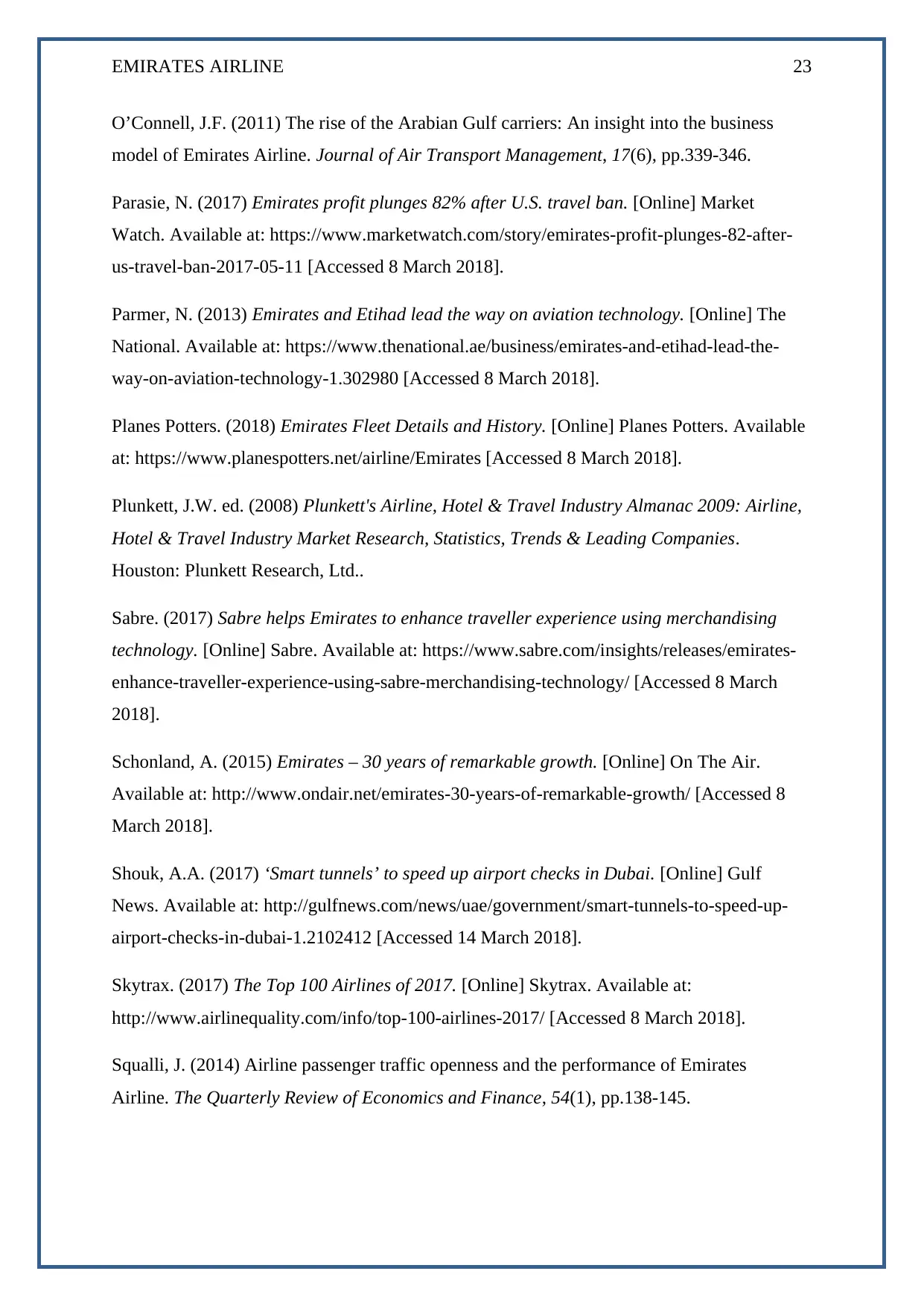
EMIRATES AIRLINE 23
O’Connell, J.F. (2011) The rise of the Arabian Gulf carriers: An insight into the business
model of Emirates Airline. Journal of Air Transport Management, 17(6), pp.339-346.
Parasie, N. (2017) Emirates profit plunges 82% after U.S. travel ban. [Online] Market
Watch. Available at: https://www.marketwatch.com/story/emirates-profit-plunges-82-after-
us-travel-ban-2017-05-11 [Accessed 8 March 2018].
Parmer, N. (2013) Emirates and Etihad lead the way on aviation technology. [Online] The
National. Available at: https://www.thenational.ae/business/emirates-and-etihad-lead-the-
way-on-aviation-technology-1.302980 [Accessed 8 March 2018].
Planes Potters. (2018) Emirates Fleet Details and History. [Online] Planes Potters. Available
at: https://www.planespotters.net/airline/Emirates [Accessed 8 March 2018].
Plunkett, J.W. ed. (2008) Plunkett's Airline, Hotel & Travel Industry Almanac 2009: Airline,
Hotel & Travel Industry Market Research, Statistics, Trends & Leading Companies.
Houston: Plunkett Research, Ltd..
Sabre. (2017) Sabre helps Emirates to enhance traveller experience using merchandising
technology. [Online] Sabre. Available at: https://www.sabre.com/insights/releases/emirates-
enhance-traveller-experience-using-sabre-merchandising-technology/ [Accessed 8 March
2018].
Schonland, A. (2015) Emirates – 30 years of remarkable growth. [Online] On The Air.
Available at: http://www.ondair.net/emirates-30-years-of-remarkable-growth/ [Accessed 8
March 2018].
Shouk, A.A. (2017) ‘Smart tunnels’ to speed up airport checks in Dubai. [Online] Gulf
News. Available at: http://gulfnews.com/news/uae/government/smart-tunnels-to-speed-up-
airport-checks-in-dubai-1.2102412 [Accessed 14 March 2018].
Skytrax. (2017) The Top 100 Airlines of 2017. [Online] Skytrax. Available at:
http://www.airlinequality.com/info/top-100-airlines-2017/ [Accessed 8 March 2018].
Squalli, J. (2014) Airline passenger traffic openness and the performance of Emirates
Airline. The Quarterly Review of Economics and Finance, 54(1), pp.138-145.
O’Connell, J.F. (2011) The rise of the Arabian Gulf carriers: An insight into the business
model of Emirates Airline. Journal of Air Transport Management, 17(6), pp.339-346.
Parasie, N. (2017) Emirates profit plunges 82% after U.S. travel ban. [Online] Market
Watch. Available at: https://www.marketwatch.com/story/emirates-profit-plunges-82-after-
us-travel-ban-2017-05-11 [Accessed 8 March 2018].
Parmer, N. (2013) Emirates and Etihad lead the way on aviation technology. [Online] The
National. Available at: https://www.thenational.ae/business/emirates-and-etihad-lead-the-
way-on-aviation-technology-1.302980 [Accessed 8 March 2018].
Planes Potters. (2018) Emirates Fleet Details and History. [Online] Planes Potters. Available
at: https://www.planespotters.net/airline/Emirates [Accessed 8 March 2018].
Plunkett, J.W. ed. (2008) Plunkett's Airline, Hotel & Travel Industry Almanac 2009: Airline,
Hotel & Travel Industry Market Research, Statistics, Trends & Leading Companies.
Houston: Plunkett Research, Ltd..
Sabre. (2017) Sabre helps Emirates to enhance traveller experience using merchandising
technology. [Online] Sabre. Available at: https://www.sabre.com/insights/releases/emirates-
enhance-traveller-experience-using-sabre-merchandising-technology/ [Accessed 8 March
2018].
Schonland, A. (2015) Emirates – 30 years of remarkable growth. [Online] On The Air.
Available at: http://www.ondair.net/emirates-30-years-of-remarkable-growth/ [Accessed 8
March 2018].
Shouk, A.A. (2017) ‘Smart tunnels’ to speed up airport checks in Dubai. [Online] Gulf
News. Available at: http://gulfnews.com/news/uae/government/smart-tunnels-to-speed-up-
airport-checks-in-dubai-1.2102412 [Accessed 14 March 2018].
Skytrax. (2017) The Top 100 Airlines of 2017. [Online] Skytrax. Available at:
http://www.airlinequality.com/info/top-100-airlines-2017/ [Accessed 8 March 2018].
Squalli, J. (2014) Airline passenger traffic openness and the performance of Emirates
Airline. The Quarterly Review of Economics and Finance, 54(1), pp.138-145.
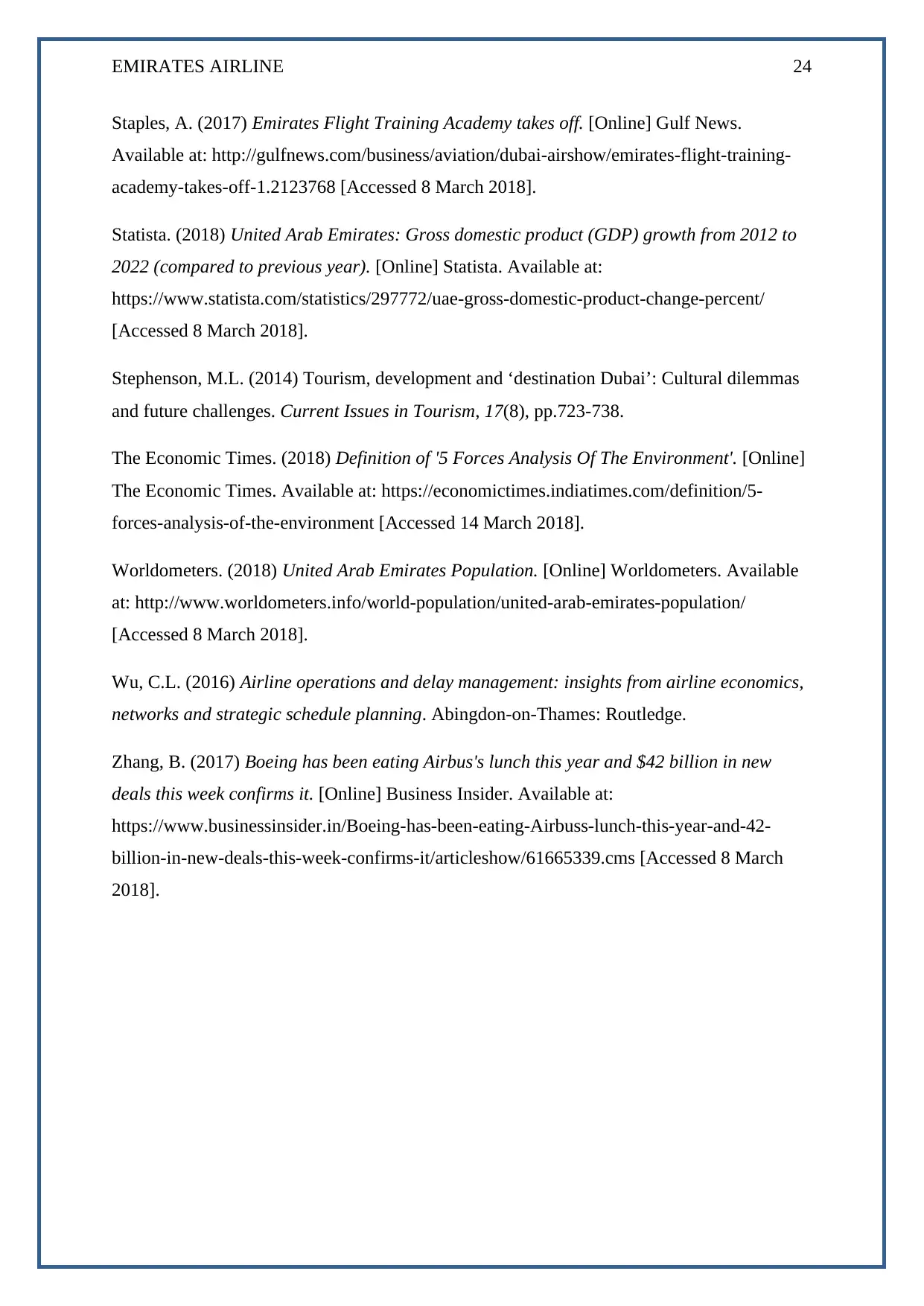
EMIRATES AIRLINE 24
Staples, A. (2017) Emirates Flight Training Academy takes off. [Online] Gulf News.
Available at: http://gulfnews.com/business/aviation/dubai-airshow/emirates-flight-training-
academy-takes-off-1.2123768 [Accessed 8 March 2018].
Statista. (2018) United Arab Emirates: Gross domestic product (GDP) growth from 2012 to
2022 (compared to previous year). [Online] Statista. Available at:
https://www.statista.com/statistics/297772/uae-gross-domestic-product-change-percent/
[Accessed 8 March 2018].
Stephenson, M.L. (2014) Tourism, development and ‘destination Dubai’: Cultural dilemmas
and future challenges. Current Issues in Tourism, 17(8), pp.723-738.
The Economic Times. (2018) Definition of '5 Forces Analysis Of The Environment'. [Online]
The Economic Times. Available at: https://economictimes.indiatimes.com/definition/5-
forces-analysis-of-the-environment [Accessed 14 March 2018].
Worldometers. (2018) United Arab Emirates Population. [Online] Worldometers. Available
at: http://www.worldometers.info/world-population/united-arab-emirates-population/
[Accessed 8 March 2018].
Wu, C.L. (2016) Airline operations and delay management: insights from airline economics,
networks and strategic schedule planning. Abingdon-on-Thames: Routledge.
Zhang, B. (2017) Boeing has been eating Airbus's lunch this year and $42 billion in new
deals this week confirms it. [Online] Business Insider. Available at:
https://www.businessinsider.in/Boeing-has-been-eating-Airbuss-lunch-this-year-and-42-
billion-in-new-deals-this-week-confirms-it/articleshow/61665339.cms [Accessed 8 March
2018].
Staples, A. (2017) Emirates Flight Training Academy takes off. [Online] Gulf News.
Available at: http://gulfnews.com/business/aviation/dubai-airshow/emirates-flight-training-
academy-takes-off-1.2123768 [Accessed 8 March 2018].
Statista. (2018) United Arab Emirates: Gross domestic product (GDP) growth from 2012 to
2022 (compared to previous year). [Online] Statista. Available at:
https://www.statista.com/statistics/297772/uae-gross-domestic-product-change-percent/
[Accessed 8 March 2018].
Stephenson, M.L. (2014) Tourism, development and ‘destination Dubai’: Cultural dilemmas
and future challenges. Current Issues in Tourism, 17(8), pp.723-738.
The Economic Times. (2018) Definition of '5 Forces Analysis Of The Environment'. [Online]
The Economic Times. Available at: https://economictimes.indiatimes.com/definition/5-
forces-analysis-of-the-environment [Accessed 14 March 2018].
Worldometers. (2018) United Arab Emirates Population. [Online] Worldometers. Available
at: http://www.worldometers.info/world-population/united-arab-emirates-population/
[Accessed 8 March 2018].
Wu, C.L. (2016) Airline operations and delay management: insights from airline economics,
networks and strategic schedule planning. Abingdon-on-Thames: Routledge.
Zhang, B. (2017) Boeing has been eating Airbus's lunch this year and $42 billion in new
deals this week confirms it. [Online] Business Insider. Available at:
https://www.businessinsider.in/Boeing-has-been-eating-Airbuss-lunch-this-year-and-42-
billion-in-new-deals-this-week-confirms-it/articleshow/61665339.cms [Accessed 8 March
2018].
1 out of 25
Related Documents
Your All-in-One AI-Powered Toolkit for Academic Success.
+13062052269
info@desklib.com
Available 24*7 on WhatsApp / Email
![[object Object]](/_next/static/media/star-bottom.7253800d.svg)
Unlock your academic potential
© 2024 | Zucol Services PVT LTD | All rights reserved.





